Solar Energy Marketing Report: Origin Energy in Australia
VerifiedAdded on 2020/05/28
|20
|4418
|290
Report
AI Summary
This report provides a comprehensive analysis of the solar energy business in Australia, with a specific focus on Origin Energy. It examines the company's products, services (particularly the Premium Plus Range), and target market, including both business and domestic consumers. The report delves into Origin's current market value, its competitive landscape, and its value creation strategies, including an analysis of the perceived value of its solar products and services. It utilizes various frameworks, such as PEST, BCG matrix, and PLC, to assess Origin's market positioning. Furthermore, the report explores Origin's promotional mix and how its elements contribute to market expansion. The findings highlight the promising future of the solar energy market in Australia and suggest that companies like Origin should invest more in their solar energy product development to gain a competitive edge.
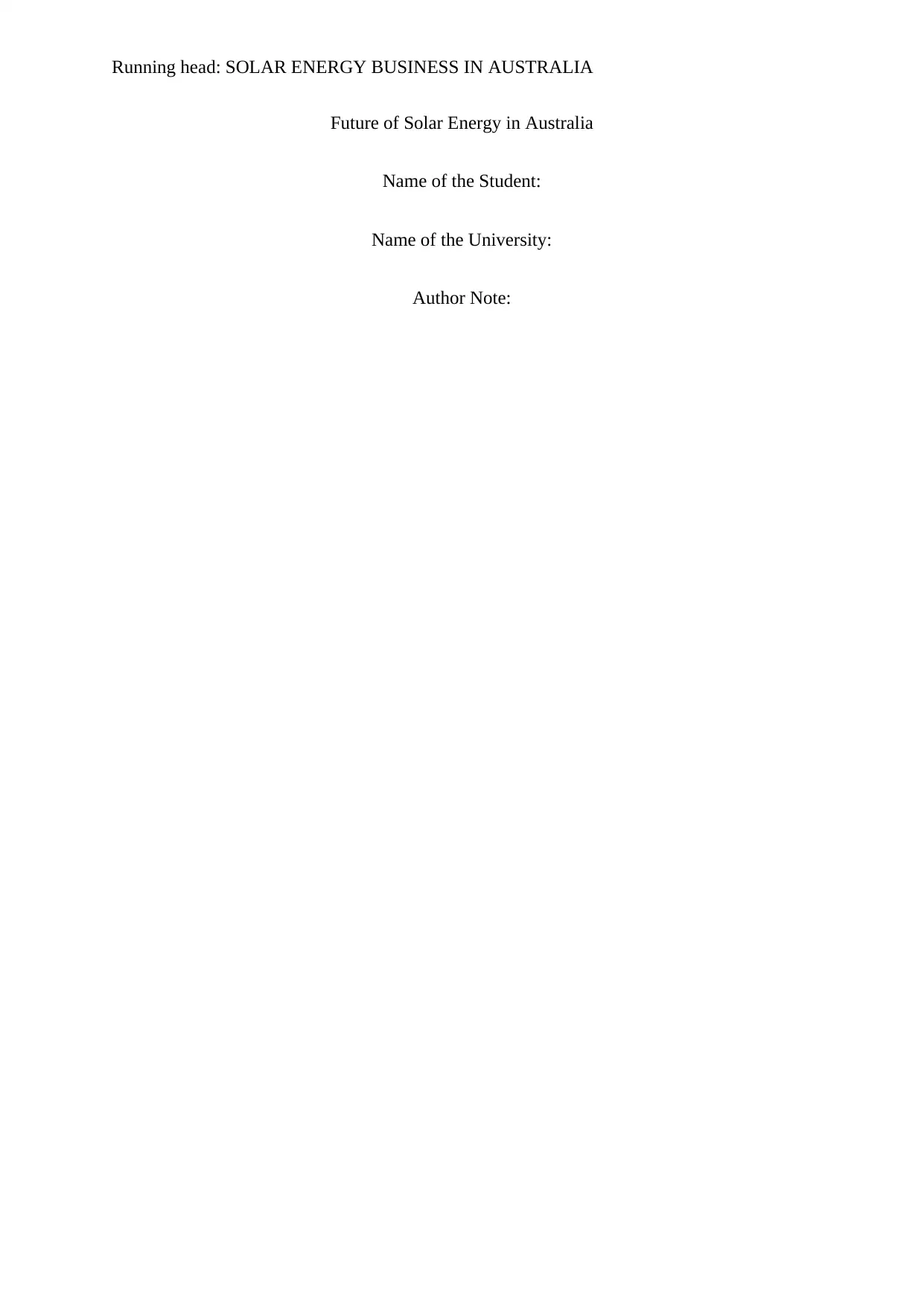
Running head: SOLAR ENERGY BUSINESS IN AUSTRALIA
Future of Solar Energy in Australia
Name of the Student:
Name of the University:
Author Note:
Future of Solar Energy in Australia
Name of the Student:
Name of the University:
Author Note:
Paraphrase This Document
Need a fresh take? Get an instant paraphrase of this document with our AI Paraphraser
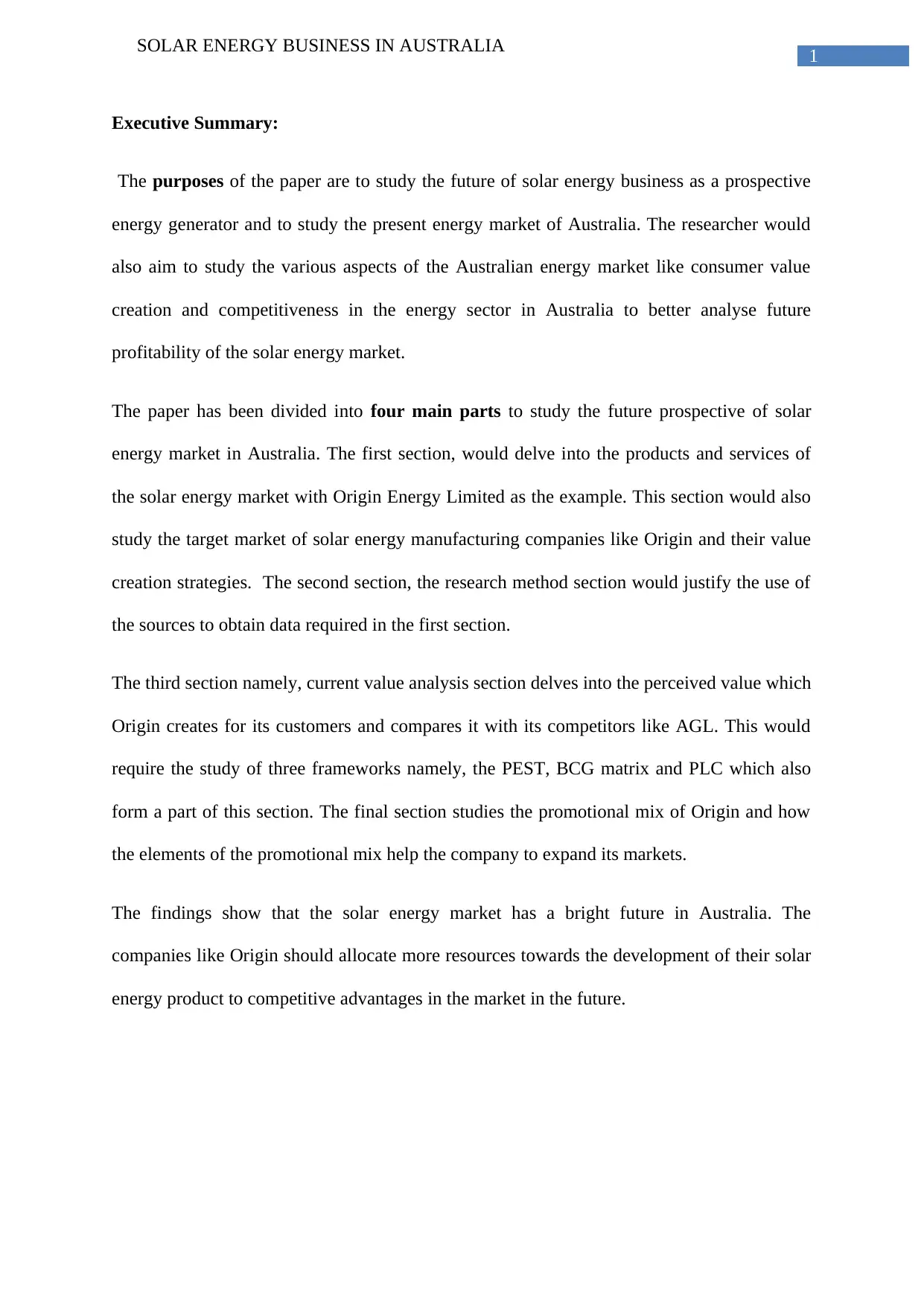
1
SOLAR ENERGY BUSINESS IN AUSTRALIA
Executive Summary:
The purposes of the paper are to study the future of solar energy business as a prospective
energy generator and to study the present energy market of Australia. The researcher would
also aim to study the various aspects of the Australian energy market like consumer value
creation and competitiveness in the energy sector in Australia to better analyse future
profitability of the solar energy market.
The paper has been divided into four main parts to study the future prospective of solar
energy market in Australia. The first section, would delve into the products and services of
the solar energy market with Origin Energy Limited as the example. This section would also
study the target market of solar energy manufacturing companies like Origin and their value
creation strategies. The second section, the research method section would justify the use of
the sources to obtain data required in the first section.
The third section namely, current value analysis section delves into the perceived value which
Origin creates for its customers and compares it with its competitors like AGL. This would
require the study of three frameworks namely, the PEST, BCG matrix and PLC which also
form a part of this section. The final section studies the promotional mix of Origin and how
the elements of the promotional mix help the company to expand its markets.
The findings show that the solar energy market has a bright future in Australia. The
companies like Origin should allocate more resources towards the development of their solar
energy product to competitive advantages in the market in the future.
SOLAR ENERGY BUSINESS IN AUSTRALIA
Executive Summary:
The purposes of the paper are to study the future of solar energy business as a prospective
energy generator and to study the present energy market of Australia. The researcher would
also aim to study the various aspects of the Australian energy market like consumer value
creation and competitiveness in the energy sector in Australia to better analyse future
profitability of the solar energy market.
The paper has been divided into four main parts to study the future prospective of solar
energy market in Australia. The first section, would delve into the products and services of
the solar energy market with Origin Energy Limited as the example. This section would also
study the target market of solar energy manufacturing companies like Origin and their value
creation strategies. The second section, the research method section would justify the use of
the sources to obtain data required in the first section.
The third section namely, current value analysis section delves into the perceived value which
Origin creates for its customers and compares it with its competitors like AGL. This would
require the study of three frameworks namely, the PEST, BCG matrix and PLC which also
form a part of this section. The final section studies the promotional mix of Origin and how
the elements of the promotional mix help the company to expand its markets.
The findings show that the solar energy market has a bright future in Australia. The
companies like Origin should allocate more resources towards the development of their solar
energy product to competitive advantages in the market in the future.
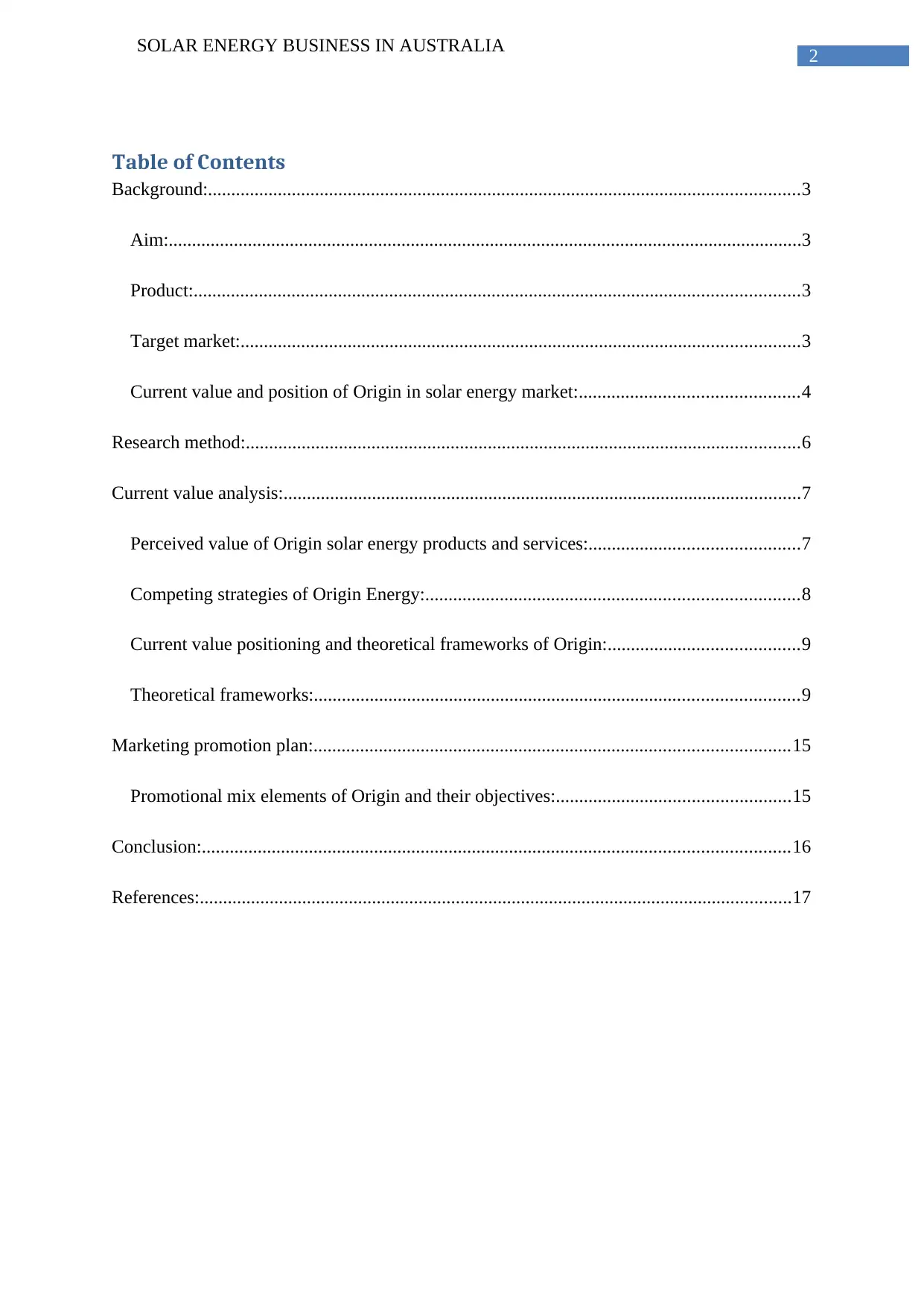
2
SOLAR ENERGY BUSINESS IN AUSTRALIA
Table of Contents
Background:...............................................................................................................................3
Aim:........................................................................................................................................3
Product:..................................................................................................................................3
Target market:........................................................................................................................3
Current value and position of Origin in solar energy market:...............................................4
Research method:.......................................................................................................................6
Current value analysis:...............................................................................................................7
Perceived value of Origin solar energy products and services:.............................................7
Competing strategies of Origin Energy:................................................................................8
Current value positioning and theoretical frameworks of Origin:.........................................9
Theoretical frameworks:........................................................................................................9
Marketing promotion plan:......................................................................................................15
Promotional mix elements of Origin and their objectives:..................................................15
Conclusion:..............................................................................................................................16
References:...............................................................................................................................17
SOLAR ENERGY BUSINESS IN AUSTRALIA
Table of Contents
Background:...............................................................................................................................3
Aim:........................................................................................................................................3
Product:..................................................................................................................................3
Target market:........................................................................................................................3
Current value and position of Origin in solar energy market:...............................................4
Research method:.......................................................................................................................6
Current value analysis:...............................................................................................................7
Perceived value of Origin solar energy products and services:.............................................7
Competing strategies of Origin Energy:................................................................................8
Current value positioning and theoretical frameworks of Origin:.........................................9
Theoretical frameworks:........................................................................................................9
Marketing promotion plan:......................................................................................................15
Promotional mix elements of Origin and their objectives:..................................................15
Conclusion:..............................................................................................................................16
References:...............................................................................................................................17
You're viewing a preview
Unlock full access by subscribing today!
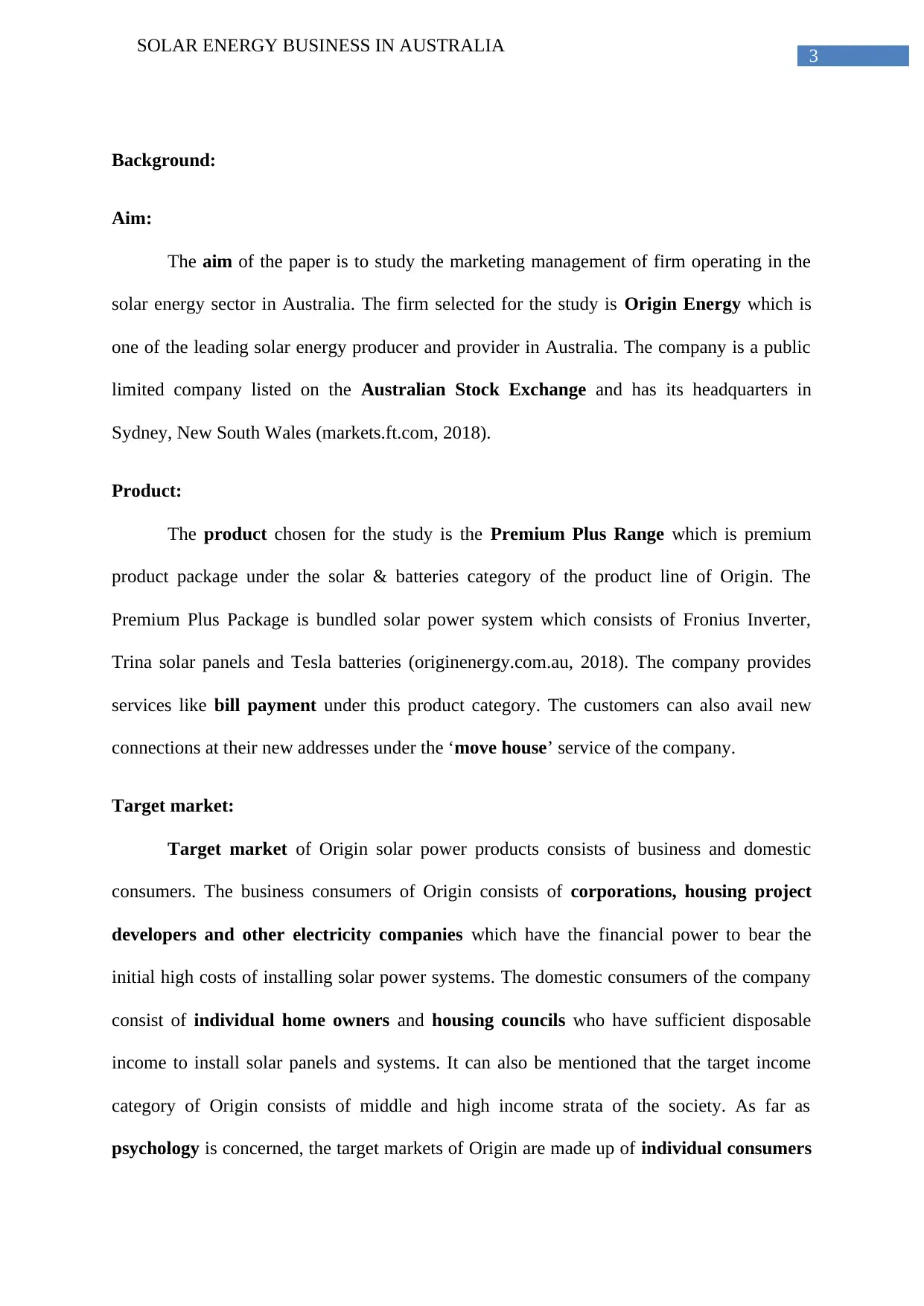
3
SOLAR ENERGY BUSINESS IN AUSTRALIA
Background:
Aim:
The aim of the paper is to study the marketing management of firm operating in the
solar energy sector in Australia. The firm selected for the study is Origin Energy which is
one of the leading solar energy producer and provider in Australia. The company is a public
limited company listed on the Australian Stock Exchange and has its headquarters in
Sydney, New South Wales (markets.ft.com, 2018).
Product:
The product chosen for the study is the Premium Plus Range which is premium
product package under the solar & batteries category of the product line of Origin. The
Premium Plus Package is bundled solar power system which consists of Fronius Inverter,
Trina solar panels and Tesla batteries (originenergy.com.au, 2018). The company provides
services like bill payment under this product category. The customers can also avail new
connections at their new addresses under the ‘move house’ service of the company.
Target market:
Target market of Origin solar power products consists of business and domestic
consumers. The business consumers of Origin consists of corporations, housing project
developers and other electricity companies which have the financial power to bear the
initial high costs of installing solar power systems. The domestic consumers of the company
consist of individual home owners and housing councils who have sufficient disposable
income to install solar panels and systems. It can also be mentioned that the target income
category of Origin consists of middle and high income strata of the society. As far as
psychology is concerned, the target markets of Origin are made up of individual consumers
SOLAR ENERGY BUSINESS IN AUSTRALIA
Background:
Aim:
The aim of the paper is to study the marketing management of firm operating in the
solar energy sector in Australia. The firm selected for the study is Origin Energy which is
one of the leading solar energy producer and provider in Australia. The company is a public
limited company listed on the Australian Stock Exchange and has its headquarters in
Sydney, New South Wales (markets.ft.com, 2018).
Product:
The product chosen for the study is the Premium Plus Range which is premium
product package under the solar & batteries category of the product line of Origin. The
Premium Plus Package is bundled solar power system which consists of Fronius Inverter,
Trina solar panels and Tesla batteries (originenergy.com.au, 2018). The company provides
services like bill payment under this product category. The customers can also avail new
connections at their new addresses under the ‘move house’ service of the company.
Target market:
Target market of Origin solar power products consists of business and domestic
consumers. The business consumers of Origin consists of corporations, housing project
developers and other electricity companies which have the financial power to bear the
initial high costs of installing solar power systems. The domestic consumers of the company
consist of individual home owners and housing councils who have sufficient disposable
income to install solar panels and systems. It can also be mentioned that the target income
category of Origin consists of middle and high income strata of the society. As far as
psychology is concerned, the target markets of Origin are made up of individual consumers
Paraphrase This Document
Need a fresh take? Get an instant paraphrase of this document with our AI Paraphraser
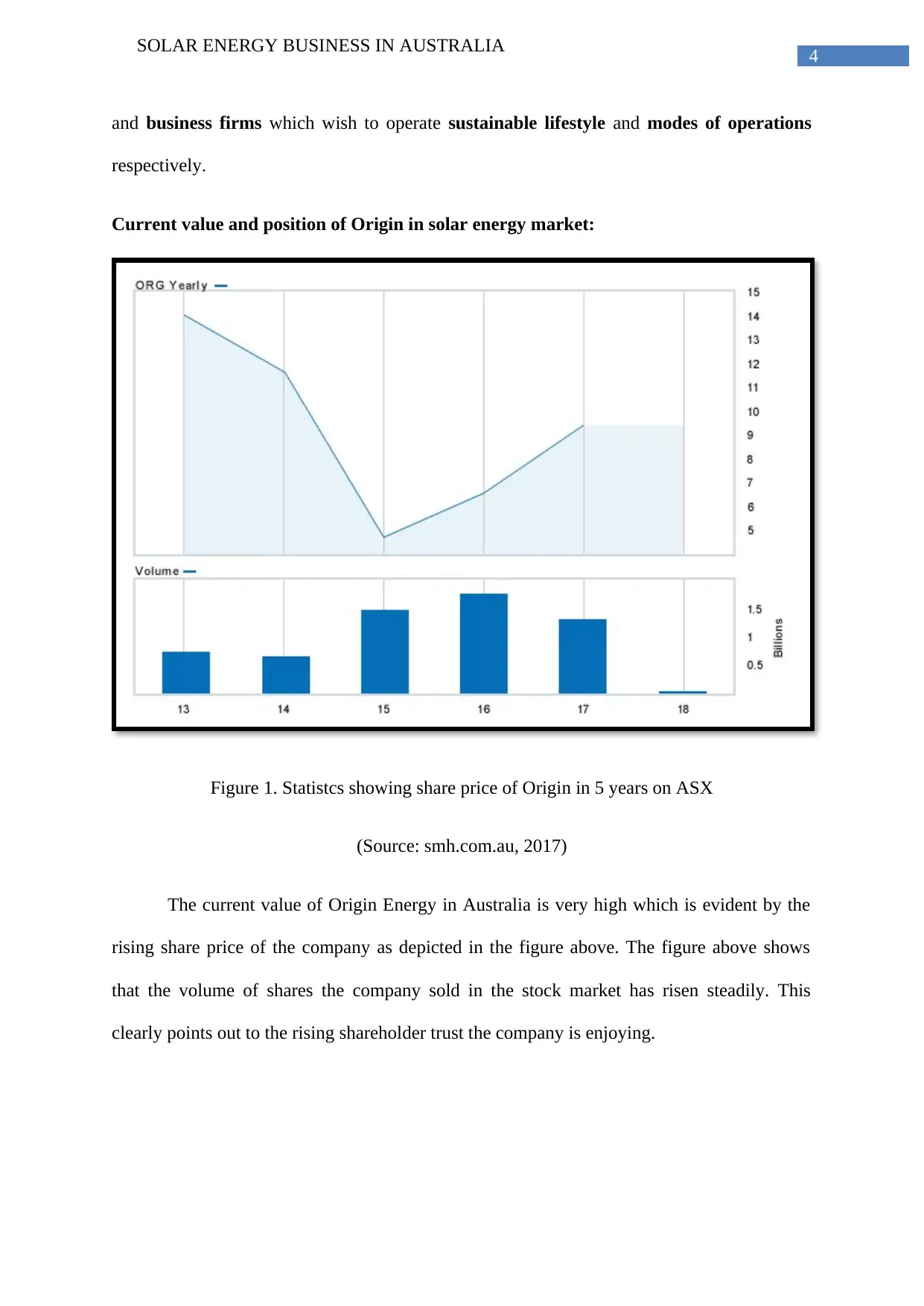
4
SOLAR ENERGY BUSINESS IN AUSTRALIA
and business firms which wish to operate sustainable lifestyle and modes of operations
respectively.
Current value and position of Origin in solar energy market:
Figure 1. Statistcs showing share price of Origin in 5 years on ASX
(Source: smh.com.au, 2017)
The current value of Origin Energy in Australia is very high which is evident by the
rising share price of the company as depicted in the figure above. The figure above shows
that the volume of shares the company sold in the stock market has risen steadily. This
clearly points out to the rising shareholder trust the company is enjoying.
SOLAR ENERGY BUSINESS IN AUSTRALIA
and business firms which wish to operate sustainable lifestyle and modes of operations
respectively.
Current value and position of Origin in solar energy market:
Figure 1. Statistcs showing share price of Origin in 5 years on ASX
(Source: smh.com.au, 2017)
The current value of Origin Energy in Australia is very high which is evident by the
rising share price of the company as depicted in the figure above. The figure above shows
that the volume of shares the company sold in the stock market has risen steadily. This
clearly points out to the rising shareholder trust the company is enjoying.
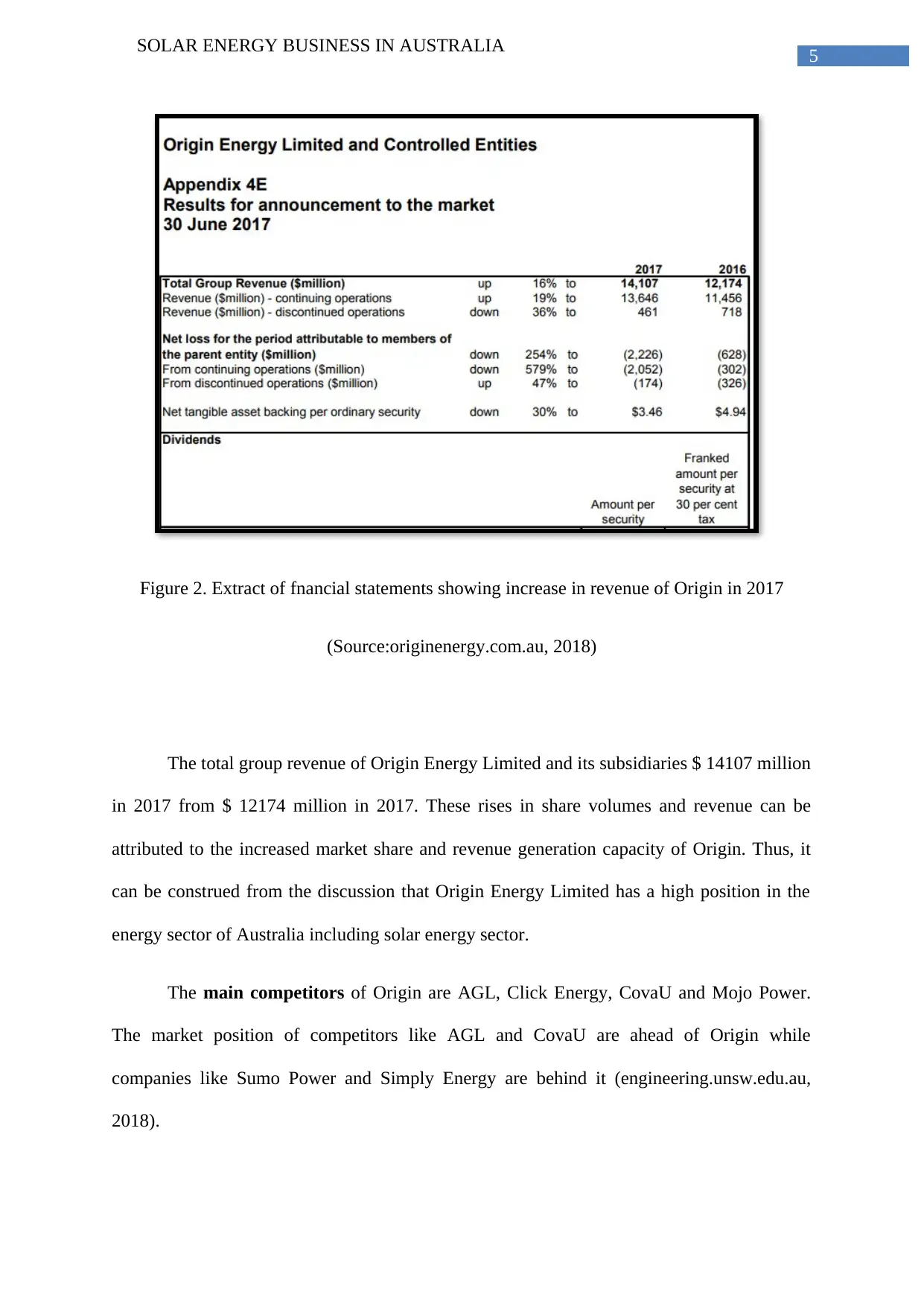
5
SOLAR ENERGY BUSINESS IN AUSTRALIA
Figure 2. Extract of fnancial statements showing increase in revenue of Origin in 2017
(Source:originenergy.com.au, 2018)
The total group revenue of Origin Energy Limited and its subsidiaries $ 14107 million
in 2017 from $ 12174 million in 2017. These rises in share volumes and revenue can be
attributed to the increased market share and revenue generation capacity of Origin. Thus, it
can be construed from the discussion that Origin Energy Limited has a high position in the
energy sector of Australia including solar energy sector.
The main competitors of Origin are AGL, Click Energy, CovaU and Mojo Power.
The market position of competitors like AGL and CovaU are ahead of Origin while
companies like Sumo Power and Simply Energy are behind it (engineering.unsw.edu.au,
2018).
SOLAR ENERGY BUSINESS IN AUSTRALIA
Figure 2. Extract of fnancial statements showing increase in revenue of Origin in 2017
(Source:originenergy.com.au, 2018)
The total group revenue of Origin Energy Limited and its subsidiaries $ 14107 million
in 2017 from $ 12174 million in 2017. These rises in share volumes and revenue can be
attributed to the increased market share and revenue generation capacity of Origin. Thus, it
can be construed from the discussion that Origin Energy Limited has a high position in the
energy sector of Australia including solar energy sector.
The main competitors of Origin are AGL, Click Energy, CovaU and Mojo Power.
The market position of competitors like AGL and CovaU are ahead of Origin while
companies like Sumo Power and Simply Energy are behind it (engineering.unsw.edu.au,
2018).
You're viewing a preview
Unlock full access by subscribing today!
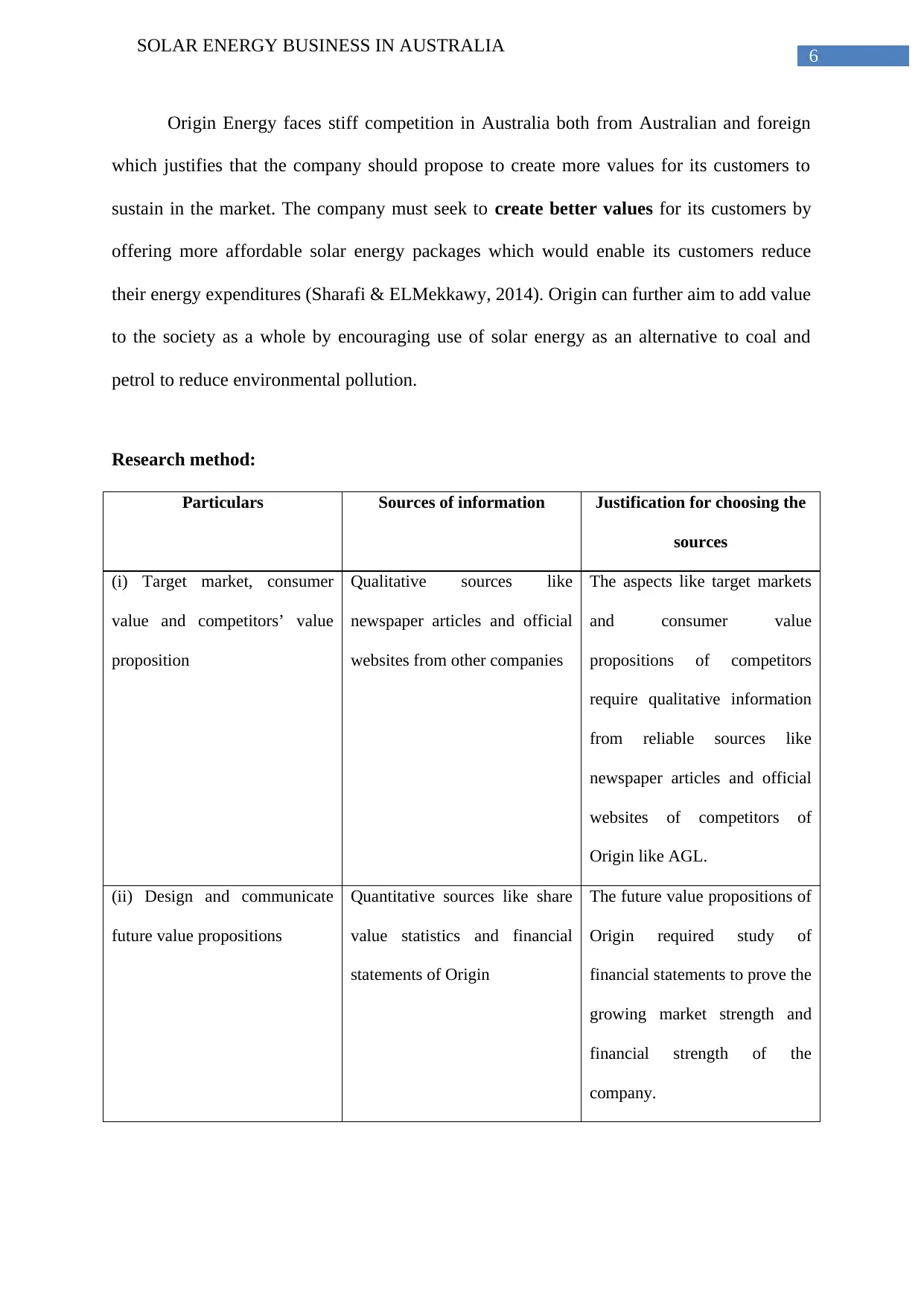
6
SOLAR ENERGY BUSINESS IN AUSTRALIA
Origin Energy faces stiff competition in Australia both from Australian and foreign
which justifies that the company should propose to create more values for its customers to
sustain in the market. The company must seek to create better values for its customers by
offering more affordable solar energy packages which would enable its customers reduce
their energy expenditures (Sharafi & ELMekkawy, 2014). Origin can further aim to add value
to the society as a whole by encouraging use of solar energy as an alternative to coal and
petrol to reduce environmental pollution.
Research method:
Particulars Sources of information Justification for choosing the
sources
(i) Target market, consumer
value and competitors’ value
proposition
Qualitative sources like
newspaper articles and official
websites from other companies
The aspects like target markets
and consumer value
propositions of competitors
require qualitative information
from reliable sources like
newspaper articles and official
websites of competitors of
Origin like AGL.
(ii) Design and communicate
future value propositions
Quantitative sources like share
value statistics and financial
statements of Origin
The future value propositions of
Origin required study of
financial statements to prove the
growing market strength and
financial strength of the
company.
SOLAR ENERGY BUSINESS IN AUSTRALIA
Origin Energy faces stiff competition in Australia both from Australian and foreign
which justifies that the company should propose to create more values for its customers to
sustain in the market. The company must seek to create better values for its customers by
offering more affordable solar energy packages which would enable its customers reduce
their energy expenditures (Sharafi & ELMekkawy, 2014). Origin can further aim to add value
to the society as a whole by encouraging use of solar energy as an alternative to coal and
petrol to reduce environmental pollution.
Research method:
Particulars Sources of information Justification for choosing the
sources
(i) Target market, consumer
value and competitors’ value
proposition
Qualitative sources like
newspaper articles and official
websites from other companies
The aspects like target markets
and consumer value
propositions of competitors
require qualitative information
from reliable sources like
newspaper articles and official
websites of competitors of
Origin like AGL.
(ii) Design and communicate
future value propositions
Quantitative sources like share
value statistics and financial
statements of Origin
The future value propositions of
Origin required study of
financial statements to prove the
growing market strength and
financial strength of the
company.
Paraphrase This Document
Need a fresh take? Get an instant paraphrase of this document with our AI Paraphraser
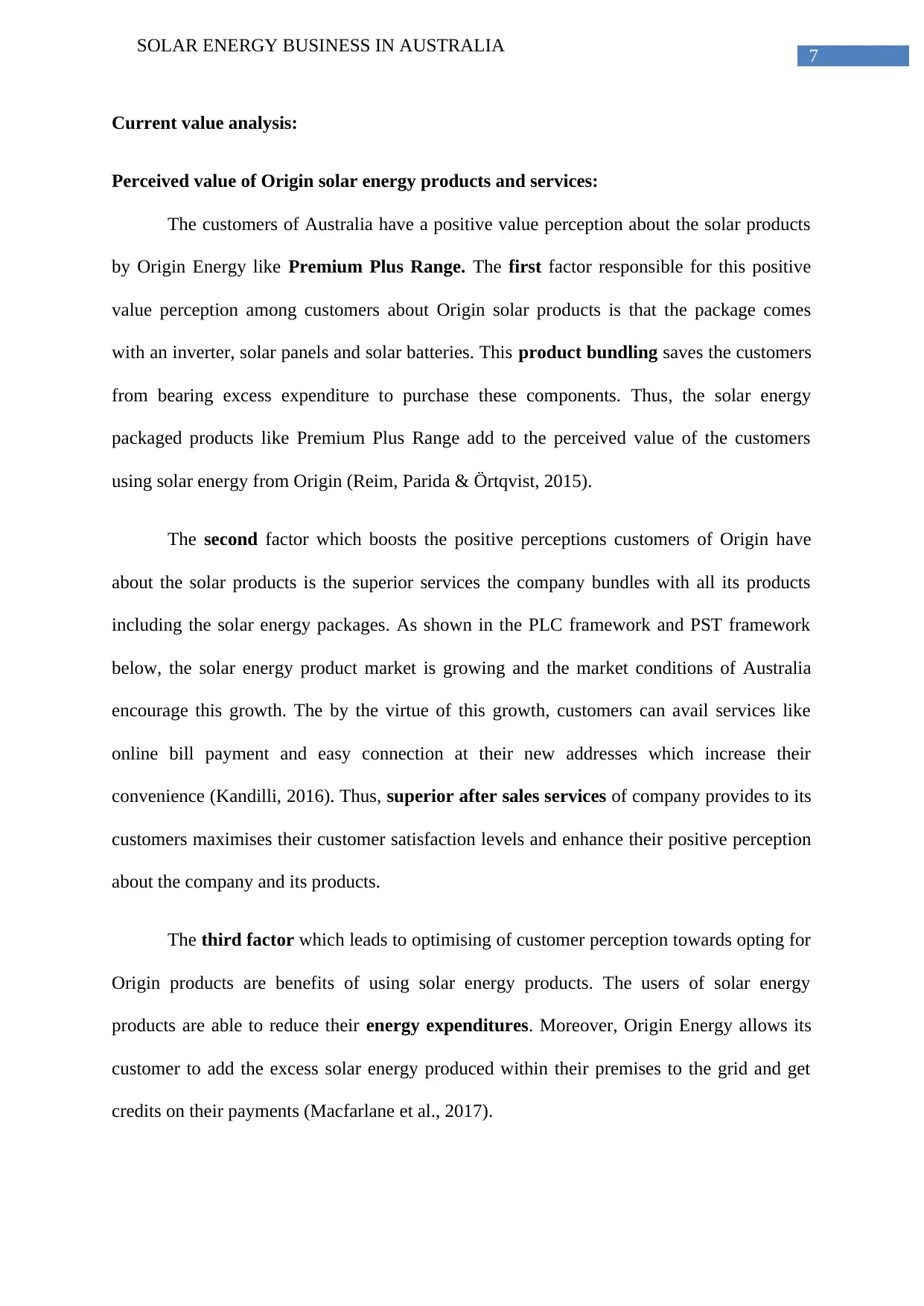
7
SOLAR ENERGY BUSINESS IN AUSTRALIA
Current value analysis:
Perceived value of Origin solar energy products and services:
The customers of Australia have a positive value perception about the solar products
by Origin Energy like Premium Plus Range. The first factor responsible for this positive
value perception among customers about Origin solar products is that the package comes
with an inverter, solar panels and solar batteries. This product bundling saves the customers
from bearing excess expenditure to purchase these components. Thus, the solar energy
packaged products like Premium Plus Range add to the perceived value of the customers
using solar energy from Origin (Reim, Parida & Örtqvist, 2015).
The second factor which boosts the positive perceptions customers of Origin have
about the solar products is the superior services the company bundles with all its products
including the solar energy packages. As shown in the PLC framework and PST framework
below, the solar energy product market is growing and the market conditions of Australia
encourage this growth. The by the virtue of this growth, customers can avail services like
online bill payment and easy connection at their new addresses which increase their
convenience (Kandilli, 2016). Thus, superior after sales services of company provides to its
customers maximises their customer satisfaction levels and enhance their positive perception
about the company and its products.
The third factor which leads to optimising of customer perception towards opting for
Origin products are benefits of using solar energy products. The users of solar energy
products are able to reduce their energy expenditures. Moreover, Origin Energy allows its
customer to add the excess solar energy produced within their premises to the grid and get
credits on their payments (Macfarlane et al., 2017).
SOLAR ENERGY BUSINESS IN AUSTRALIA
Current value analysis:
Perceived value of Origin solar energy products and services:
The customers of Australia have a positive value perception about the solar products
by Origin Energy like Premium Plus Range. The first factor responsible for this positive
value perception among customers about Origin solar products is that the package comes
with an inverter, solar panels and solar batteries. This product bundling saves the customers
from bearing excess expenditure to purchase these components. Thus, the solar energy
packaged products like Premium Plus Range add to the perceived value of the customers
using solar energy from Origin (Reim, Parida & Örtqvist, 2015).
The second factor which boosts the positive perceptions customers of Origin have
about the solar products is the superior services the company bundles with all its products
including the solar energy packages. As shown in the PLC framework and PST framework
below, the solar energy product market is growing and the market conditions of Australia
encourage this growth. The by the virtue of this growth, customers can avail services like
online bill payment and easy connection at their new addresses which increase their
convenience (Kandilli, 2016). Thus, superior after sales services of company provides to its
customers maximises their customer satisfaction levels and enhance their positive perception
about the company and its products.
The third factor which leads to optimising of customer perception towards opting for
Origin products are benefits of using solar energy products. The users of solar energy
products are able to reduce their energy expenditures. Moreover, Origin Energy allows its
customer to add the excess solar energy produced within their premises to the grid and get
credits on their payments (Macfarlane et al., 2017).
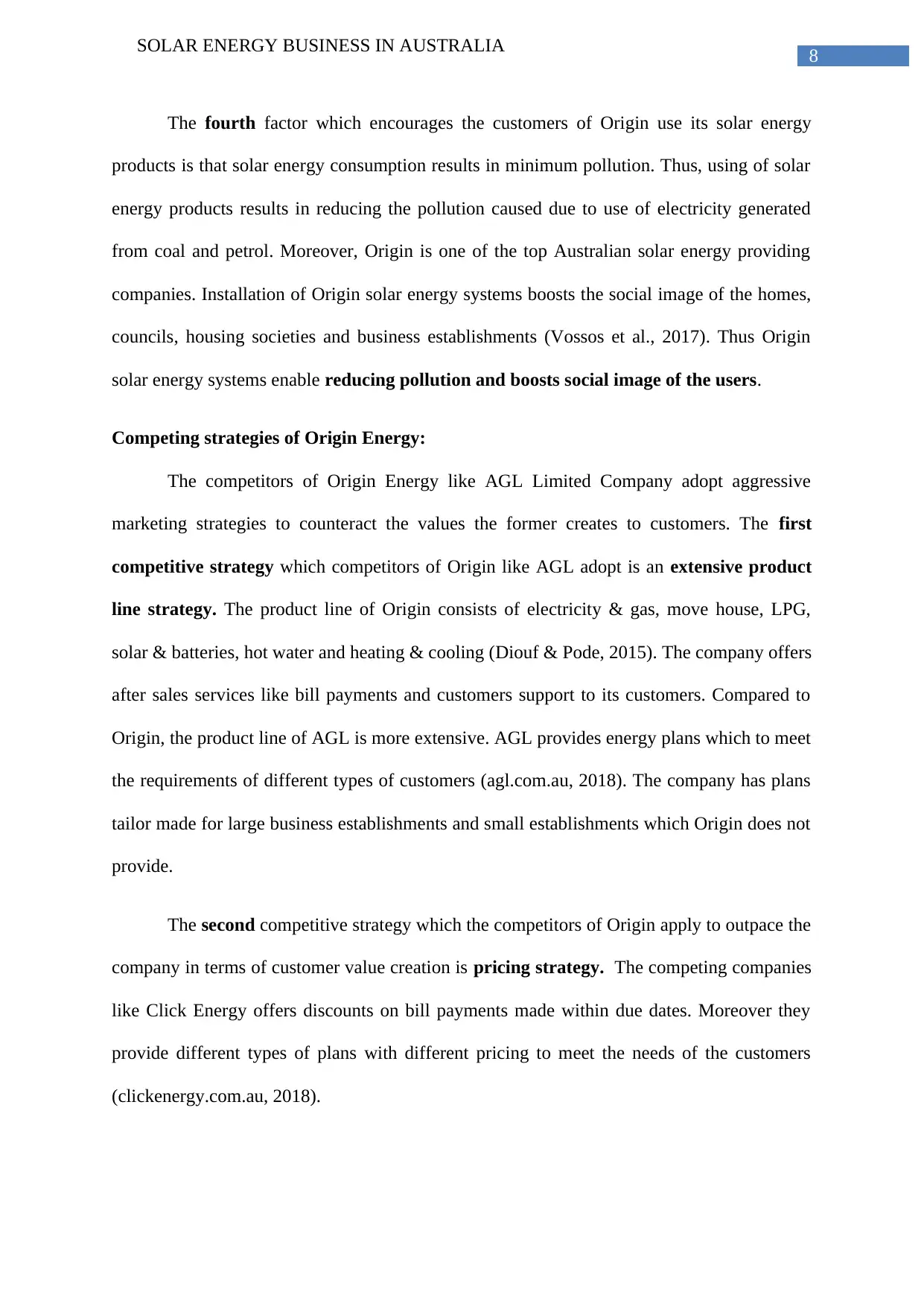
8
SOLAR ENERGY BUSINESS IN AUSTRALIA
The fourth factor which encourages the customers of Origin use its solar energy
products is that solar energy consumption results in minimum pollution. Thus, using of solar
energy products results in reducing the pollution caused due to use of electricity generated
from coal and petrol. Moreover, Origin is one of the top Australian solar energy providing
companies. Installation of Origin solar energy systems boosts the social image of the homes,
councils, housing societies and business establishments (Vossos et al., 2017). Thus Origin
solar energy systems enable reducing pollution and boosts social image of the users.
Competing strategies of Origin Energy:
The competitors of Origin Energy like AGL Limited Company adopt aggressive
marketing strategies to counteract the values the former creates to customers. The first
competitive strategy which competitors of Origin like AGL adopt is an extensive product
line strategy. The product line of Origin consists of electricity & gas, move house, LPG,
solar & batteries, hot water and heating & cooling (Diouf & Pode, 2015). The company offers
after sales services like bill payments and customers support to its customers. Compared to
Origin, the product line of AGL is more extensive. AGL provides energy plans which to meet
the requirements of different types of customers (agl.com.au, 2018). The company has plans
tailor made for large business establishments and small establishments which Origin does not
provide.
The second competitive strategy which the competitors of Origin apply to outpace the
company in terms of customer value creation is pricing strategy. The competing companies
like Click Energy offers discounts on bill payments made within due dates. Moreover they
provide different types of plans with different pricing to meet the needs of the customers
(clickenergy.com.au, 2018).
SOLAR ENERGY BUSINESS IN AUSTRALIA
The fourth factor which encourages the customers of Origin use its solar energy
products is that solar energy consumption results in minimum pollution. Thus, using of solar
energy products results in reducing the pollution caused due to use of electricity generated
from coal and petrol. Moreover, Origin is one of the top Australian solar energy providing
companies. Installation of Origin solar energy systems boosts the social image of the homes,
councils, housing societies and business establishments (Vossos et al., 2017). Thus Origin
solar energy systems enable reducing pollution and boosts social image of the users.
Competing strategies of Origin Energy:
The competitors of Origin Energy like AGL Limited Company adopt aggressive
marketing strategies to counteract the values the former creates to customers. The first
competitive strategy which competitors of Origin like AGL adopt is an extensive product
line strategy. The product line of Origin consists of electricity & gas, move house, LPG,
solar & batteries, hot water and heating & cooling (Diouf & Pode, 2015). The company offers
after sales services like bill payments and customers support to its customers. Compared to
Origin, the product line of AGL is more extensive. AGL provides energy plans which to meet
the requirements of different types of customers (agl.com.au, 2018). The company has plans
tailor made for large business establishments and small establishments which Origin does not
provide.
The second competitive strategy which the competitors of Origin apply to outpace the
company in terms of customer value creation is pricing strategy. The competing companies
like Click Energy offers discounts on bill payments made within due dates. Moreover they
provide different types of plans with different pricing to meet the needs of the customers
(clickenergy.com.au, 2018).
You're viewing a preview
Unlock full access by subscribing today!
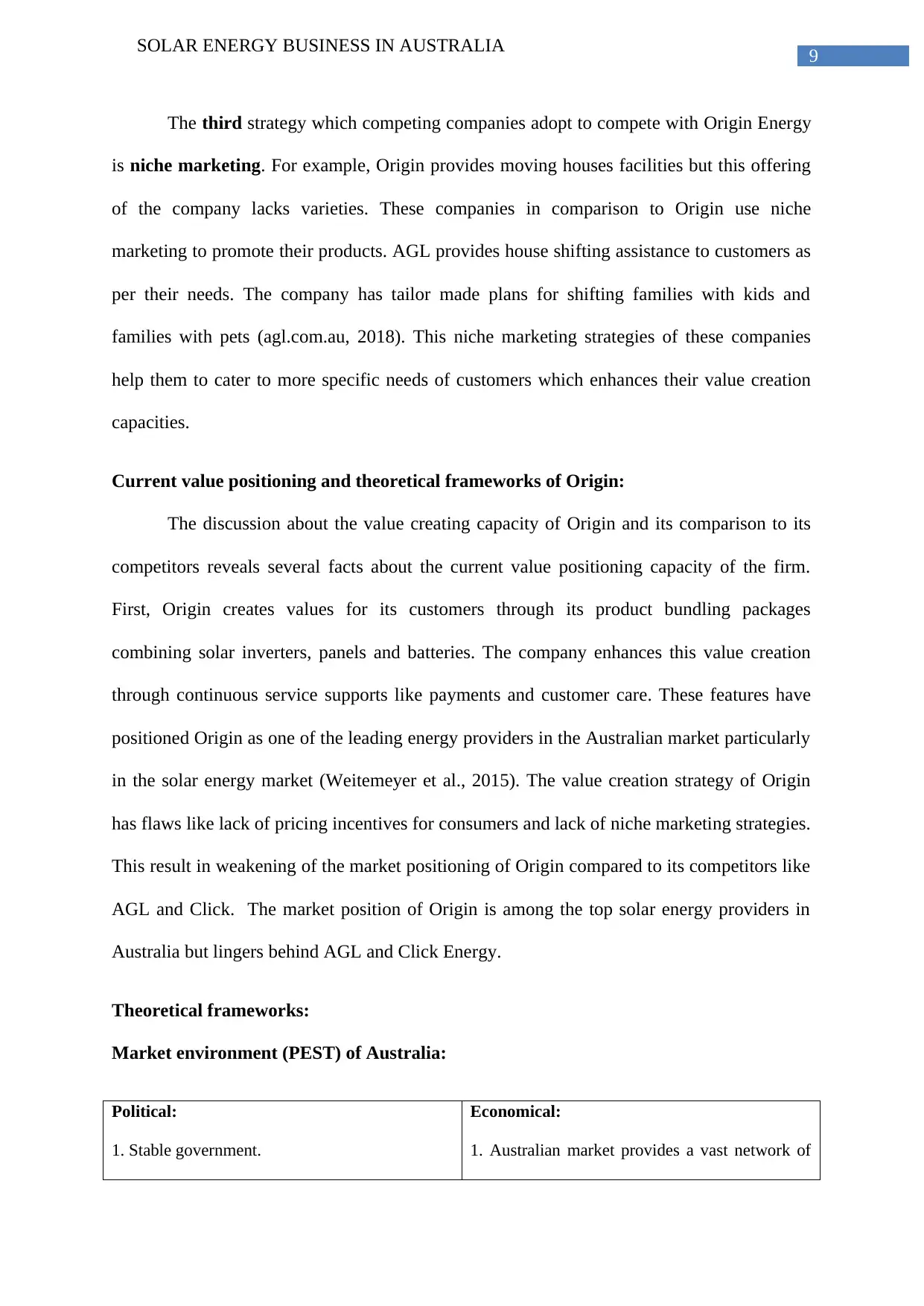
9
SOLAR ENERGY BUSINESS IN AUSTRALIA
The third strategy which competing companies adopt to compete with Origin Energy
is niche marketing. For example, Origin provides moving houses facilities but this offering
of the company lacks varieties. These companies in comparison to Origin use niche
marketing to promote their products. AGL provides house shifting assistance to customers as
per their needs. The company has tailor made plans for shifting families with kids and
families with pets (agl.com.au, 2018). This niche marketing strategies of these companies
help them to cater to more specific needs of customers which enhances their value creation
capacities.
Current value positioning and theoretical frameworks of Origin:
The discussion about the value creating capacity of Origin and its comparison to its
competitors reveals several facts about the current value positioning capacity of the firm.
First, Origin creates values for its customers through its product bundling packages
combining solar inverters, panels and batteries. The company enhances this value creation
through continuous service supports like payments and customer care. These features have
positioned Origin as one of the leading energy providers in the Australian market particularly
in the solar energy market (Weitemeyer et al., 2015). The value creation strategy of Origin
has flaws like lack of pricing incentives for consumers and lack of niche marketing strategies.
This result in weakening of the market positioning of Origin compared to its competitors like
AGL and Click. The market position of Origin is among the top solar energy providers in
Australia but lingers behind AGL and Click Energy.
Theoretical frameworks:
Market environment (PEST) of Australia:
Political:
1. Stable government.
Economical:
1. Australian market provides a vast network of
SOLAR ENERGY BUSINESS IN AUSTRALIA
The third strategy which competing companies adopt to compete with Origin Energy
is niche marketing. For example, Origin provides moving houses facilities but this offering
of the company lacks varieties. These companies in comparison to Origin use niche
marketing to promote their products. AGL provides house shifting assistance to customers as
per their needs. The company has tailor made plans for shifting families with kids and
families with pets (agl.com.au, 2018). This niche marketing strategies of these companies
help them to cater to more specific needs of customers which enhances their value creation
capacities.
Current value positioning and theoretical frameworks of Origin:
The discussion about the value creating capacity of Origin and its comparison to its
competitors reveals several facts about the current value positioning capacity of the firm.
First, Origin creates values for its customers through its product bundling packages
combining solar inverters, panels and batteries. The company enhances this value creation
through continuous service supports like payments and customer care. These features have
positioned Origin as one of the leading energy providers in the Australian market particularly
in the solar energy market (Weitemeyer et al., 2015). The value creation strategy of Origin
has flaws like lack of pricing incentives for consumers and lack of niche marketing strategies.
This result in weakening of the market positioning of Origin compared to its competitors like
AGL and Click. The market position of Origin is among the top solar energy providers in
Australia but lingers behind AGL and Click Energy.
Theoretical frameworks:
Market environment (PEST) of Australia:
Political:
1. Stable government.
Economical:
1. Australian market provides a vast network of
Paraphrase This Document
Need a fresh take? Get an instant paraphrase of this document with our AI Paraphraser
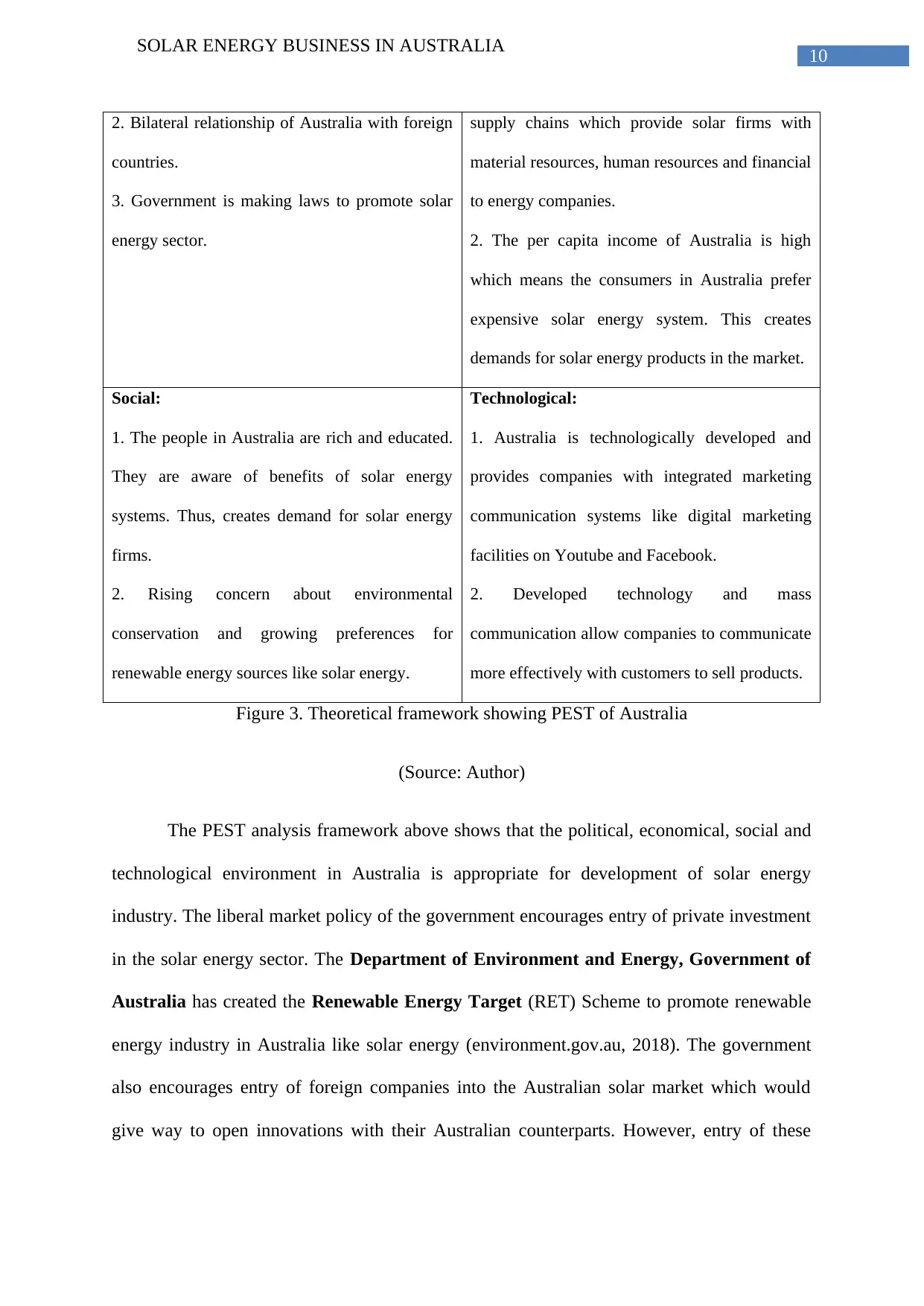
10
SOLAR ENERGY BUSINESS IN AUSTRALIA
2. Bilateral relationship of Australia with foreign
countries.
3. Government is making laws to promote solar
energy sector.
supply chains which provide solar firms with
material resources, human resources and financial
to energy companies.
2. The per capita income of Australia is high
which means the consumers in Australia prefer
expensive solar energy system. This creates
demands for solar energy products in the market.
Social:
1. The people in Australia are rich and educated.
They are aware of benefits of solar energy
systems. Thus, creates demand for solar energy
firms.
2. Rising concern about environmental
conservation and growing preferences for
renewable energy sources like solar energy.
Technological:
1. Australia is technologically developed and
provides companies with integrated marketing
communication systems like digital marketing
facilities on Youtube and Facebook.
2. Developed technology and mass
communication allow companies to communicate
more effectively with customers to sell products.
Figure 3. Theoretical framework showing PEST of Australia
(Source: Author)
The PEST analysis framework above shows that the political, economical, social and
technological environment in Australia is appropriate for development of solar energy
industry. The liberal market policy of the government encourages entry of private investment
in the solar energy sector. The Department of Environment and Energy, Government of
Australia has created the Renewable Energy Target (RET) Scheme to promote renewable
energy industry in Australia like solar energy (environment.gov.au, 2018). The government
also encourages entry of foreign companies into the Australian solar market which would
give way to open innovations with their Australian counterparts. However, entry of these
SOLAR ENERGY BUSINESS IN AUSTRALIA
2. Bilateral relationship of Australia with foreign
countries.
3. Government is making laws to promote solar
energy sector.
supply chains which provide solar firms with
material resources, human resources and financial
to energy companies.
2. The per capita income of Australia is high
which means the consumers in Australia prefer
expensive solar energy system. This creates
demands for solar energy products in the market.
Social:
1. The people in Australia are rich and educated.
They are aware of benefits of solar energy
systems. Thus, creates demand for solar energy
firms.
2. Rising concern about environmental
conservation and growing preferences for
renewable energy sources like solar energy.
Technological:
1. Australia is technologically developed and
provides companies with integrated marketing
communication systems like digital marketing
facilities on Youtube and Facebook.
2. Developed technology and mass
communication allow companies to communicate
more effectively with customers to sell products.
Figure 3. Theoretical framework showing PEST of Australia
(Source: Author)
The PEST analysis framework above shows that the political, economical, social and
technological environment in Australia is appropriate for development of solar energy
industry. The liberal market policy of the government encourages entry of private investment
in the solar energy sector. The Department of Environment and Energy, Government of
Australia has created the Renewable Energy Target (RET) Scheme to promote renewable
energy industry in Australia like solar energy (environment.gov.au, 2018). The government
also encourages entry of foreign companies into the Australian solar market which would
give way to open innovations with their Australian counterparts. However, entry of these
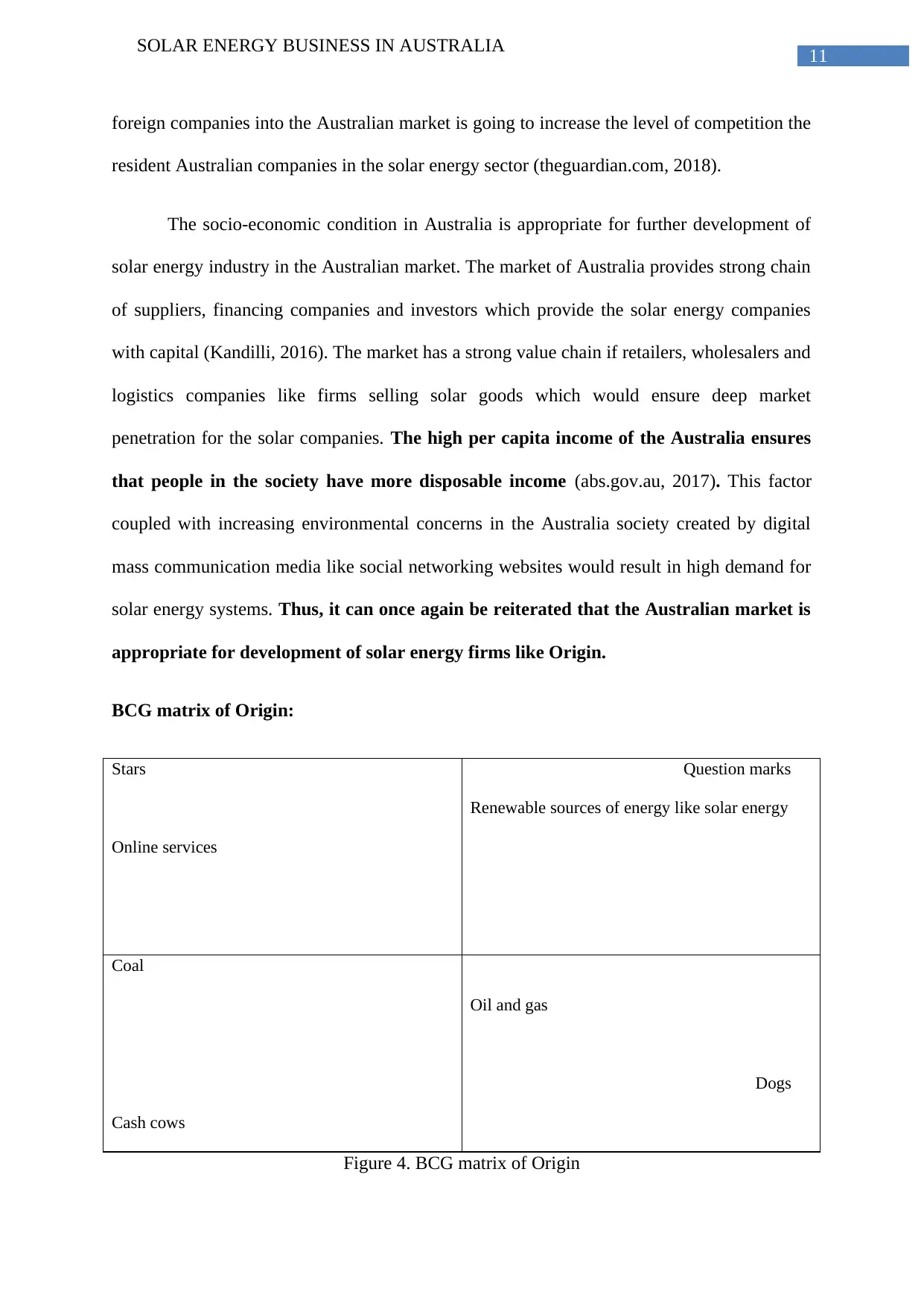
11
SOLAR ENERGY BUSINESS IN AUSTRALIA
foreign companies into the Australian market is going to increase the level of competition the
resident Australian companies in the solar energy sector (theguardian.com, 2018).
The socio-economic condition in Australia is appropriate for further development of
solar energy industry in the Australian market. The market of Australia provides strong chain
of suppliers, financing companies and investors which provide the solar energy companies
with capital (Kandilli, 2016). The market has a strong value chain if retailers, wholesalers and
logistics companies like firms selling solar goods which would ensure deep market
penetration for the solar companies. The high per capita income of the Australia ensures
that people in the society have more disposable income (abs.gov.au, 2017). This factor
coupled with increasing environmental concerns in the Australia society created by digital
mass communication media like social networking websites would result in high demand for
solar energy systems. Thus, it can once again be reiterated that the Australian market is
appropriate for development of solar energy firms like Origin.
BCG matrix of Origin:
Stars
Online services
Question marks
Renewable sources of energy like solar energy
Coal
Cash cows
Oil and gas
Dogs
Figure 4. BCG matrix of Origin
SOLAR ENERGY BUSINESS IN AUSTRALIA
foreign companies into the Australian market is going to increase the level of competition the
resident Australian companies in the solar energy sector (theguardian.com, 2018).
The socio-economic condition in Australia is appropriate for further development of
solar energy industry in the Australian market. The market of Australia provides strong chain
of suppliers, financing companies and investors which provide the solar energy companies
with capital (Kandilli, 2016). The market has a strong value chain if retailers, wholesalers and
logistics companies like firms selling solar goods which would ensure deep market
penetration for the solar companies. The high per capita income of the Australia ensures
that people in the society have more disposable income (abs.gov.au, 2017). This factor
coupled with increasing environmental concerns in the Australia society created by digital
mass communication media like social networking websites would result in high demand for
solar energy systems. Thus, it can once again be reiterated that the Australian market is
appropriate for development of solar energy firms like Origin.
BCG matrix of Origin:
Stars
Online services
Question marks
Renewable sources of energy like solar energy
Coal
Cash cows
Oil and gas
Dogs
Figure 4. BCG matrix of Origin
You're viewing a preview
Unlock full access by subscribing today!
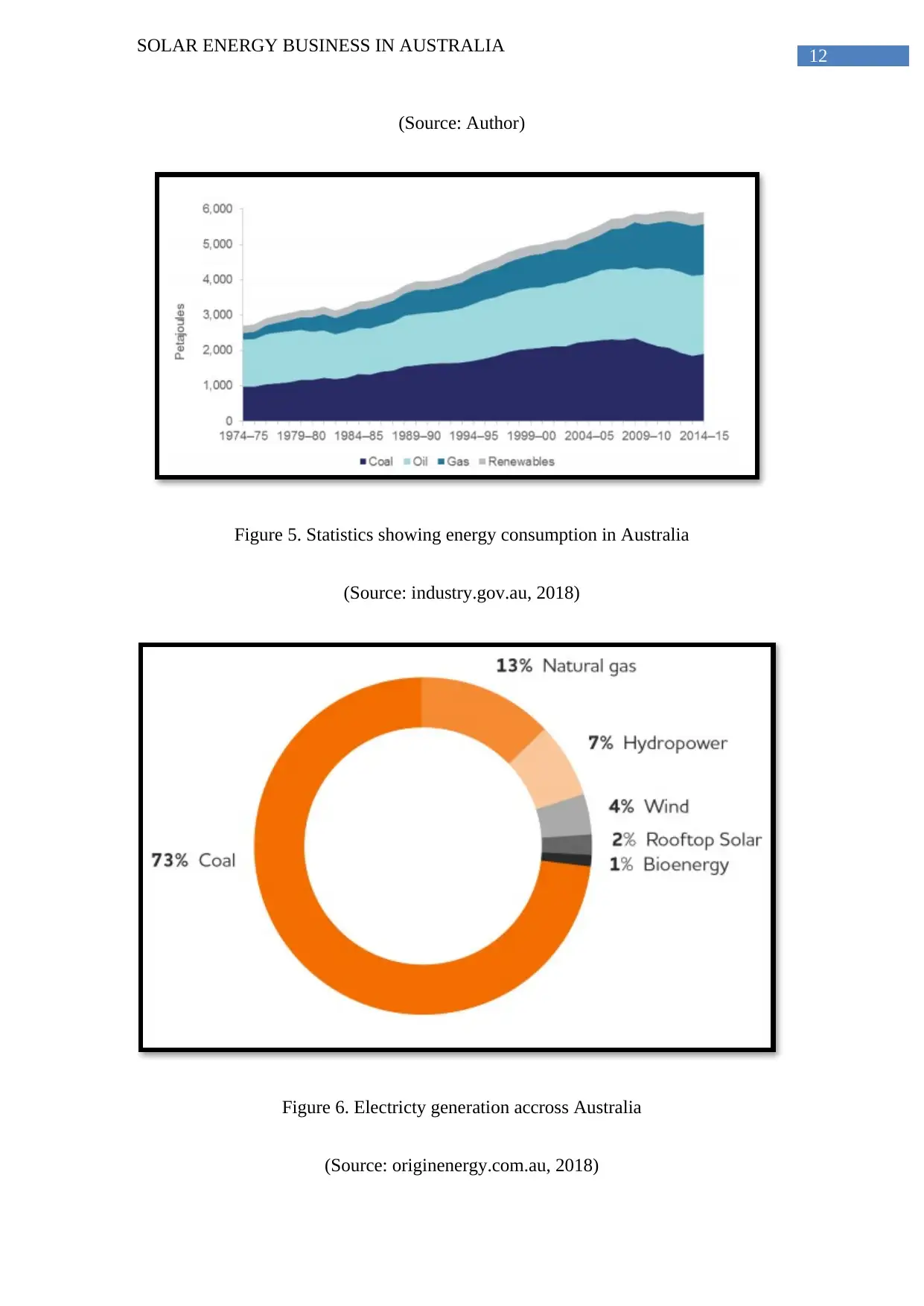
12
SOLAR ENERGY BUSINESS IN AUSTRALIA
(Source: Author)
Figure 5. Statistics showing energy consumption in Australia
(Source: industry.gov.au, 2018)
Figure 6. Electricty generation accross Australia
(Source: originenergy.com.au, 2018)
SOLAR ENERGY BUSINESS IN AUSTRALIA
(Source: Author)
Figure 5. Statistics showing energy consumption in Australia
(Source: industry.gov.au, 2018)
Figure 6. Electricty generation accross Australia
(Source: originenergy.com.au, 2018)
Paraphrase This Document
Need a fresh take? Get an instant paraphrase of this document with our AI Paraphraser
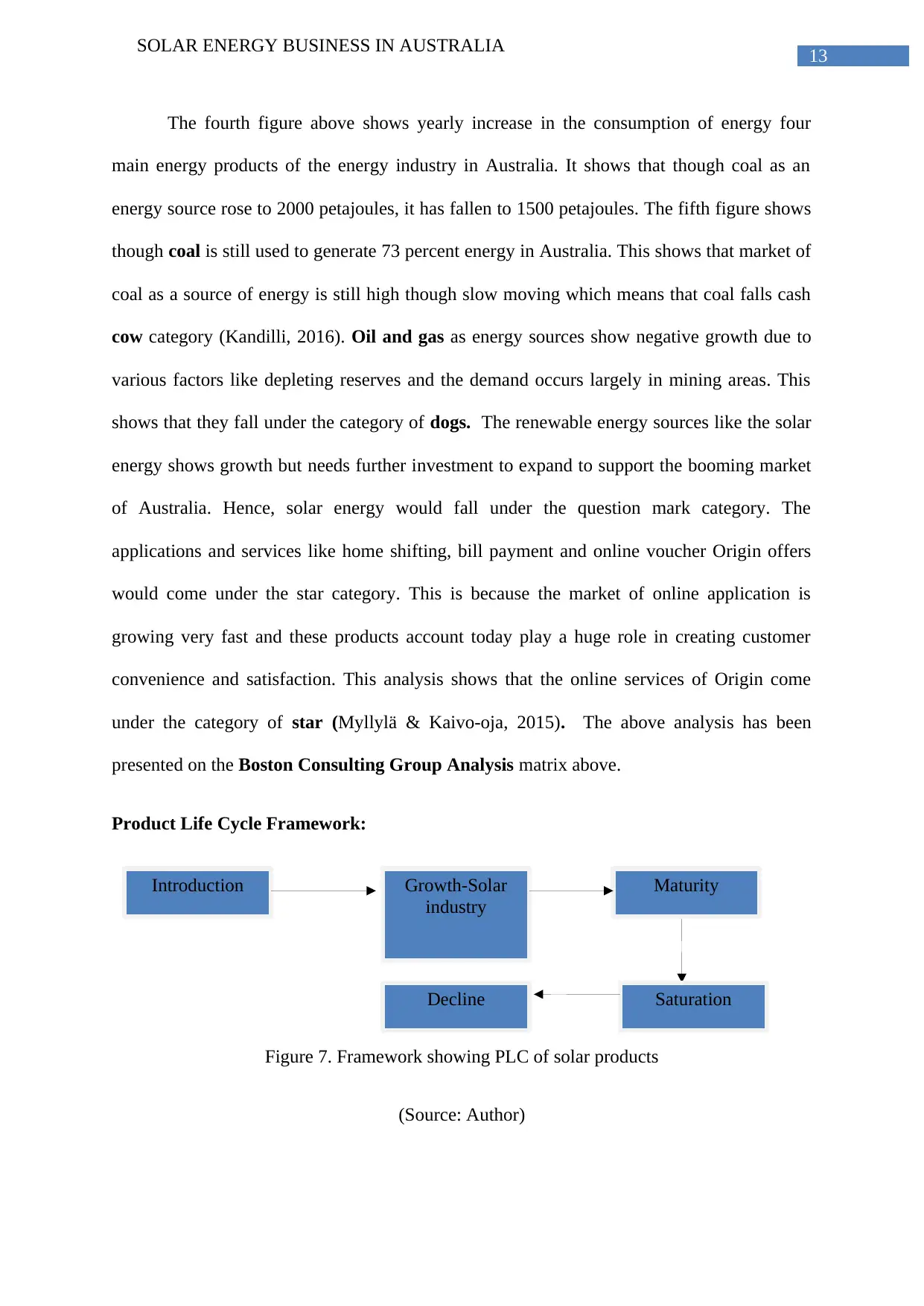
13
SOLAR ENERGY BUSINESS IN AUSTRALIA
Introduction Growth-Solar
industry
Maturity
SaturationDecline
The fourth figure above shows yearly increase in the consumption of energy four
main energy products of the energy industry in Australia. It shows that though coal as an
energy source rose to 2000 petajoules, it has fallen to 1500 petajoules. The fifth figure shows
though coal is still used to generate 73 percent energy in Australia. This shows that market of
coal as a source of energy is still high though slow moving which means that coal falls cash
cow category (Kandilli, 2016). Oil and gas as energy sources show negative growth due to
various factors like depleting reserves and the demand occurs largely in mining areas. This
shows that they fall under the category of dogs. The renewable energy sources like the solar
energy shows growth but needs further investment to expand to support the booming market
of Australia. Hence, solar energy would fall under the question mark category. The
applications and services like home shifting, bill payment and online voucher Origin offers
would come under the star category. This is because the market of online application is
growing very fast and these products account today play a huge role in creating customer
convenience and satisfaction. This analysis shows that the online services of Origin come
under the category of star (Myllylä & Kaivo-oja, 2015). The above analysis has been
presented on the Boston Consulting Group Analysis matrix above.
Product Life Cycle Framework:
Figure 7. Framework showing PLC of solar products
(Source: Author)
SOLAR ENERGY BUSINESS IN AUSTRALIA
Introduction Growth-Solar
industry
Maturity
SaturationDecline
The fourth figure above shows yearly increase in the consumption of energy four
main energy products of the energy industry in Australia. It shows that though coal as an
energy source rose to 2000 petajoules, it has fallen to 1500 petajoules. The fifth figure shows
though coal is still used to generate 73 percent energy in Australia. This shows that market of
coal as a source of energy is still high though slow moving which means that coal falls cash
cow category (Kandilli, 2016). Oil and gas as energy sources show negative growth due to
various factors like depleting reserves and the demand occurs largely in mining areas. This
shows that they fall under the category of dogs. The renewable energy sources like the solar
energy shows growth but needs further investment to expand to support the booming market
of Australia. Hence, solar energy would fall under the question mark category. The
applications and services like home shifting, bill payment and online voucher Origin offers
would come under the star category. This is because the market of online application is
growing very fast and these products account today play a huge role in creating customer
convenience and satisfaction. This analysis shows that the online services of Origin come
under the category of star (Myllylä & Kaivo-oja, 2015). The above analysis has been
presented on the Boston Consulting Group Analysis matrix above.
Product Life Cycle Framework:
Figure 7. Framework showing PLC of solar products
(Source: Author)
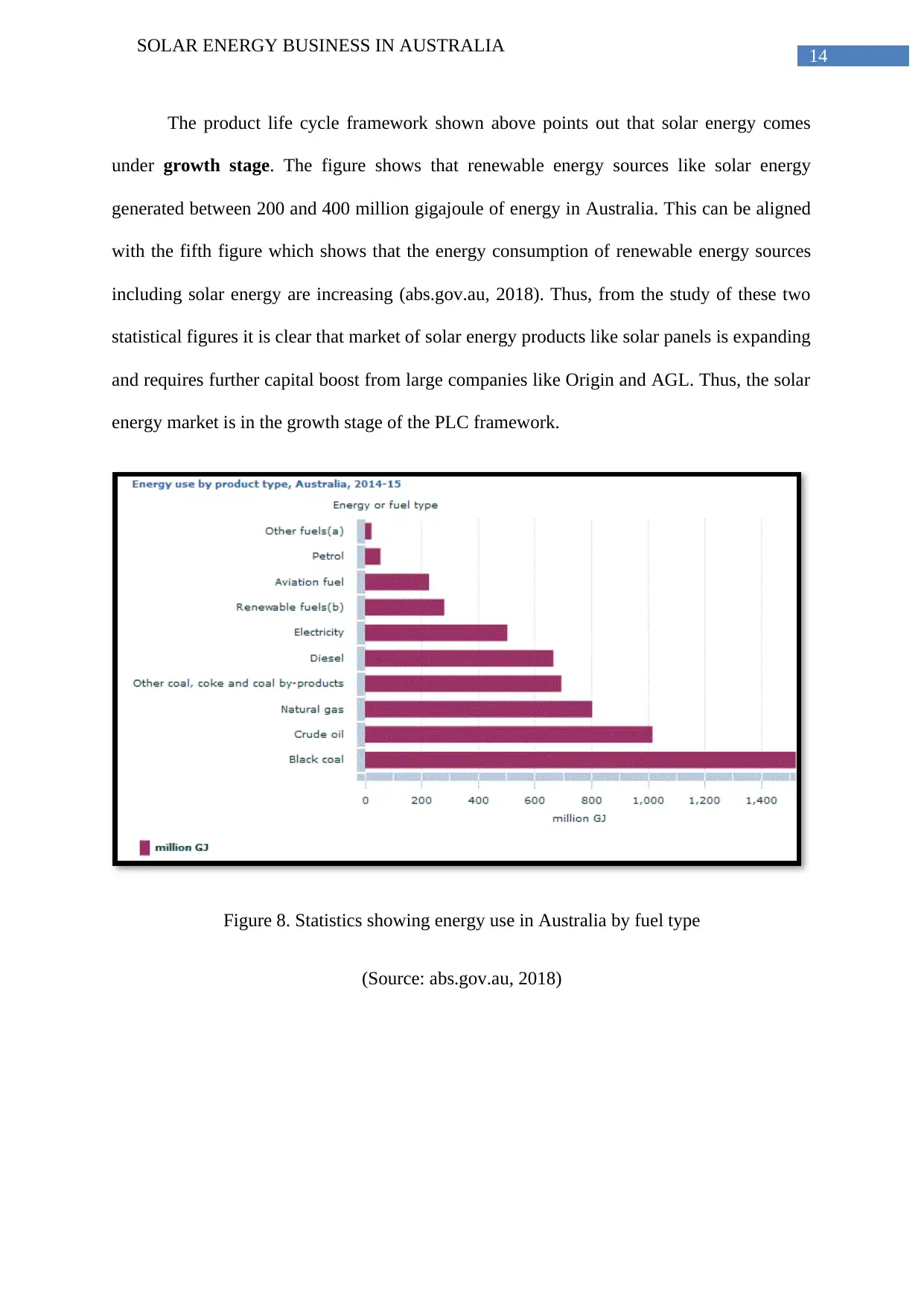
14
SOLAR ENERGY BUSINESS IN AUSTRALIA
The product life cycle framework shown above points out that solar energy comes
under growth stage. The figure shows that renewable energy sources like solar energy
generated between 200 and 400 million gigajoule of energy in Australia. This can be aligned
with the fifth figure which shows that the energy consumption of renewable energy sources
including solar energy are increasing (abs.gov.au, 2018). Thus, from the study of these two
statistical figures it is clear that market of solar energy products like solar panels is expanding
and requires further capital boost from large companies like Origin and AGL. Thus, the solar
energy market is in the growth stage of the PLC framework.
Figure 8. Statistics showing energy use in Australia by fuel type
(Source: abs.gov.au, 2018)
SOLAR ENERGY BUSINESS IN AUSTRALIA
The product life cycle framework shown above points out that solar energy comes
under growth stage. The figure shows that renewable energy sources like solar energy
generated between 200 and 400 million gigajoule of energy in Australia. This can be aligned
with the fifth figure which shows that the energy consumption of renewable energy sources
including solar energy are increasing (abs.gov.au, 2018). Thus, from the study of these two
statistical figures it is clear that market of solar energy products like solar panels is expanding
and requires further capital boost from large companies like Origin and AGL. Thus, the solar
energy market is in the growth stage of the PLC framework.
Figure 8. Statistics showing energy use in Australia by fuel type
(Source: abs.gov.au, 2018)
You're viewing a preview
Unlock full access by subscribing today!
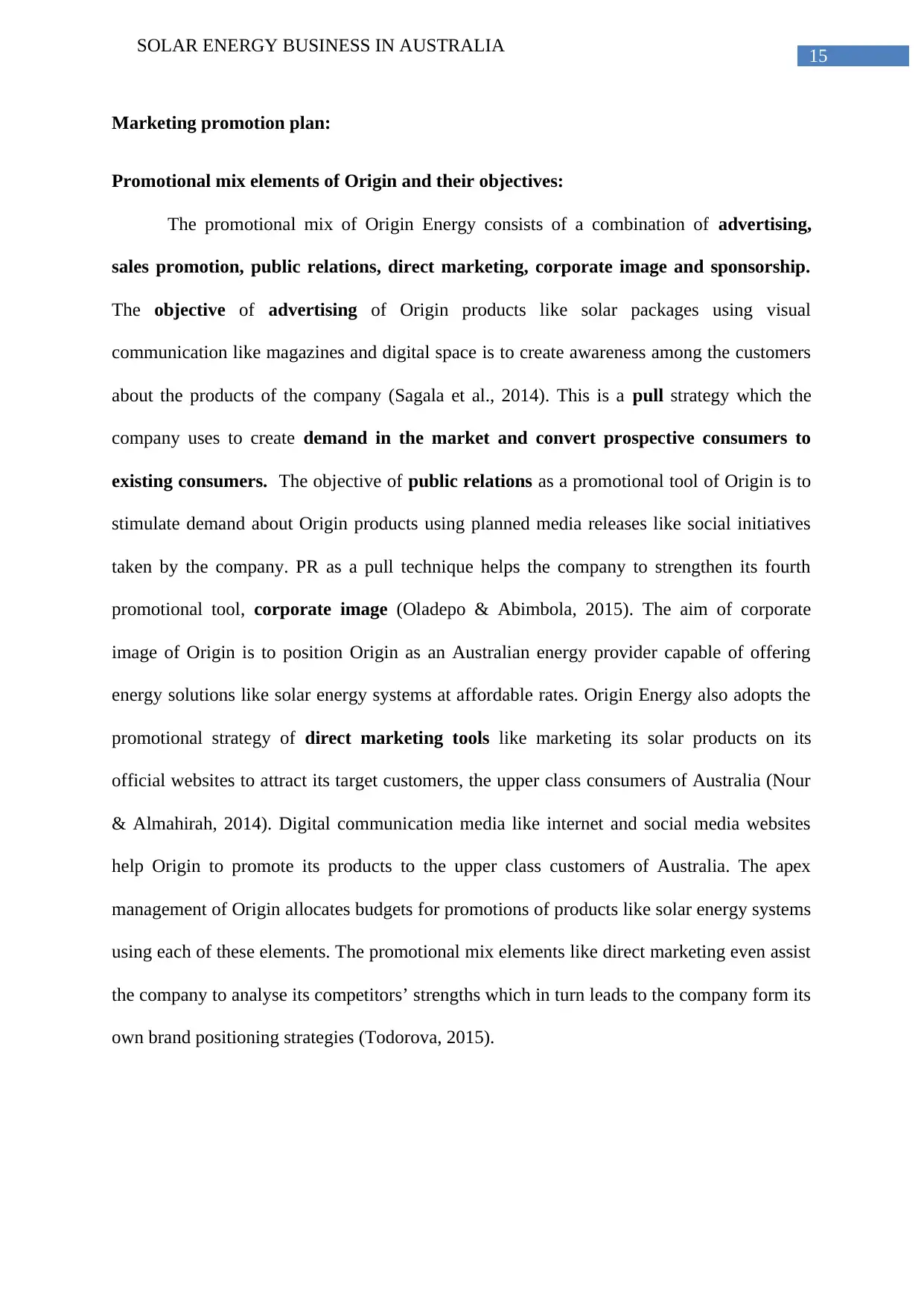
15
SOLAR ENERGY BUSINESS IN AUSTRALIA
Marketing promotion plan:
Promotional mix elements of Origin and their objectives:
The promotional mix of Origin Energy consists of a combination of advertising,
sales promotion, public relations, direct marketing, corporate image and sponsorship.
The objective of advertising of Origin products like solar packages using visual
communication like magazines and digital space is to create awareness among the customers
about the products of the company (Sagala et al., 2014). This is a pull strategy which the
company uses to create demand in the market and convert prospective consumers to
existing consumers. The objective of public relations as a promotional tool of Origin is to
stimulate demand about Origin products using planned media releases like social initiatives
taken by the company. PR as a pull technique helps the company to strengthen its fourth
promotional tool, corporate image (Oladepo & Abimbola, 2015). The aim of corporate
image of Origin is to position Origin as an Australian energy provider capable of offering
energy solutions like solar energy systems at affordable rates. Origin Energy also adopts the
promotional strategy of direct marketing tools like marketing its solar products on its
official websites to attract its target customers, the upper class consumers of Australia (Nour
& Almahirah, 2014). Digital communication media like internet and social media websites
help Origin to promote its products to the upper class customers of Australia. The apex
management of Origin allocates budgets for promotions of products like solar energy systems
using each of these elements. The promotional mix elements like direct marketing even assist
the company to analyse its competitors’ strengths which in turn leads to the company form its
own brand positioning strategies (Todorova, 2015).
SOLAR ENERGY BUSINESS IN AUSTRALIA
Marketing promotion plan:
Promotional mix elements of Origin and their objectives:
The promotional mix of Origin Energy consists of a combination of advertising,
sales promotion, public relations, direct marketing, corporate image and sponsorship.
The objective of advertising of Origin products like solar packages using visual
communication like magazines and digital space is to create awareness among the customers
about the products of the company (Sagala et al., 2014). This is a pull strategy which the
company uses to create demand in the market and convert prospective consumers to
existing consumers. The objective of public relations as a promotional tool of Origin is to
stimulate demand about Origin products using planned media releases like social initiatives
taken by the company. PR as a pull technique helps the company to strengthen its fourth
promotional tool, corporate image (Oladepo & Abimbola, 2015). The aim of corporate
image of Origin is to position Origin as an Australian energy provider capable of offering
energy solutions like solar energy systems at affordable rates. Origin Energy also adopts the
promotional strategy of direct marketing tools like marketing its solar products on its
official websites to attract its target customers, the upper class consumers of Australia (Nour
& Almahirah, 2014). Digital communication media like internet and social media websites
help Origin to promote its products to the upper class customers of Australia. The apex
management of Origin allocates budgets for promotions of products like solar energy systems
using each of these elements. The promotional mix elements like direct marketing even assist
the company to analyse its competitors’ strengths which in turn leads to the company form its
own brand positioning strategies (Todorova, 2015).
Paraphrase This Document
Need a fresh take? Get an instant paraphrase of this document with our AI Paraphraser
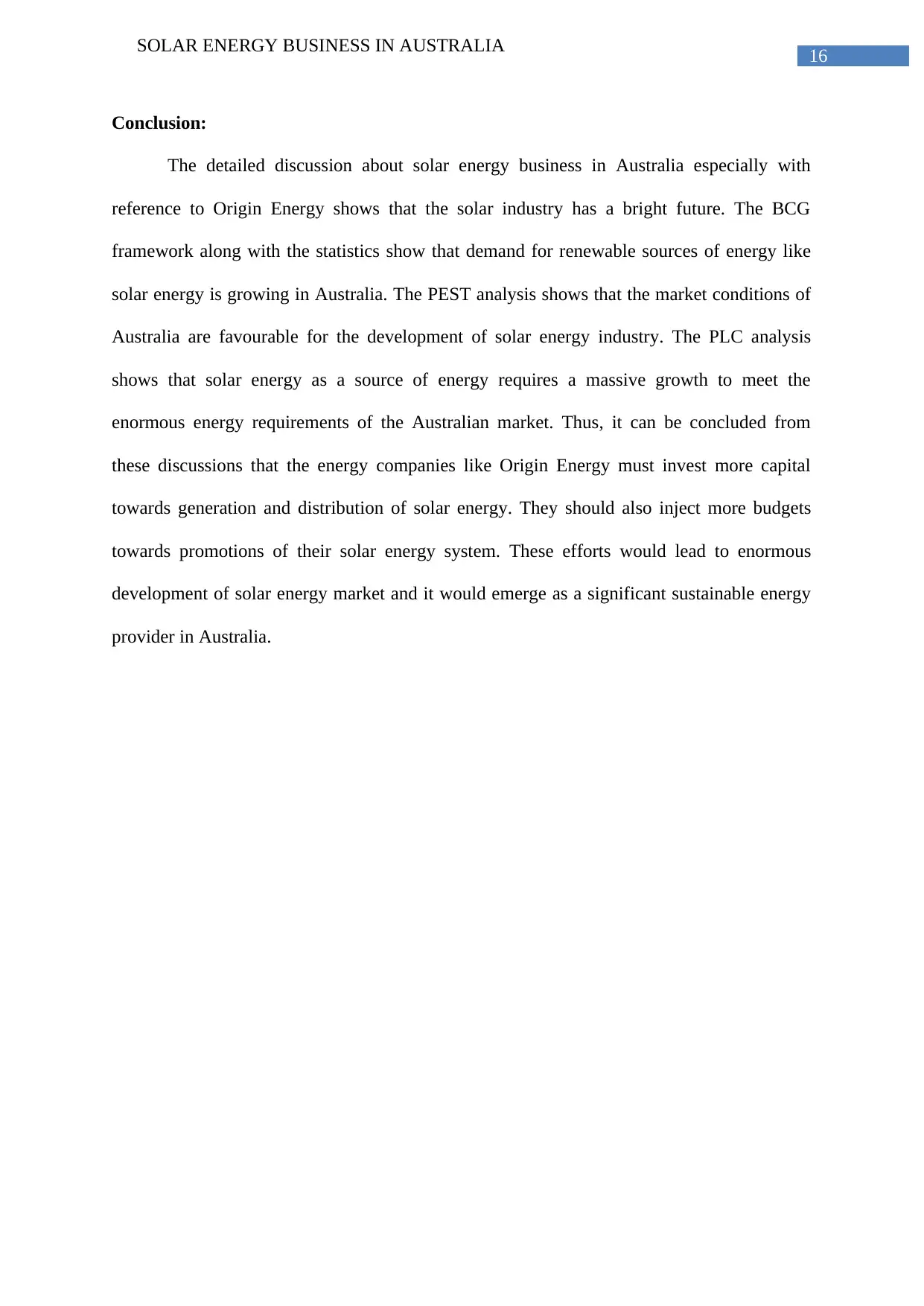
16
SOLAR ENERGY BUSINESS IN AUSTRALIA
Conclusion:
The detailed discussion about solar energy business in Australia especially with
reference to Origin Energy shows that the solar industry has a bright future. The BCG
framework along with the statistics show that demand for renewable sources of energy like
solar energy is growing in Australia. The PEST analysis shows that the market conditions of
Australia are favourable for the development of solar energy industry. The PLC analysis
shows that solar energy as a source of energy requires a massive growth to meet the
enormous energy requirements of the Australian market. Thus, it can be concluded from
these discussions that the energy companies like Origin Energy must invest more capital
towards generation and distribution of solar energy. They should also inject more budgets
towards promotions of their solar energy system. These efforts would lead to enormous
development of solar energy market and it would emerge as a significant sustainable energy
provider in Australia.
SOLAR ENERGY BUSINESS IN AUSTRALIA
Conclusion:
The detailed discussion about solar energy business in Australia especially with
reference to Origin Energy shows that the solar industry has a bright future. The BCG
framework along with the statistics show that demand for renewable sources of energy like
solar energy is growing in Australia. The PEST analysis shows that the market conditions of
Australia are favourable for the development of solar energy industry. The PLC analysis
shows that solar energy as a source of energy requires a massive growth to meet the
enormous energy requirements of the Australian market. Thus, it can be concluded from
these discussions that the energy companies like Origin Energy must invest more capital
towards generation and distribution of solar energy. They should also inject more budgets
towards promotions of their solar energy system. These efforts would lead to enormous
development of solar energy market and it would emerge as a significant sustainable energy
provider in Australia.
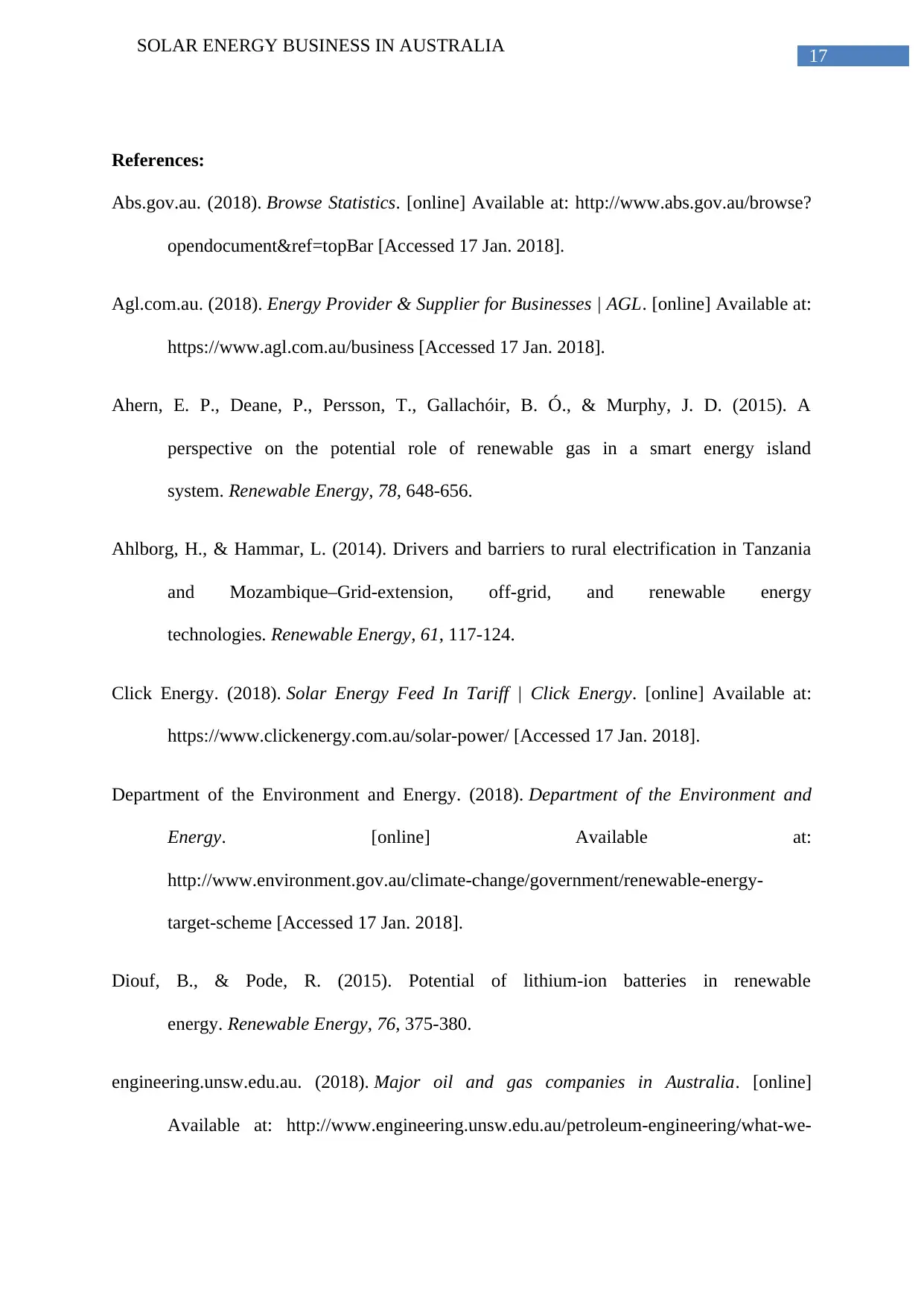
17
SOLAR ENERGY BUSINESS IN AUSTRALIA
References:
Abs.gov.au. (2018). Browse Statistics. [online] Available at: http://www.abs.gov.au/browse?
opendocument&ref=topBar [Accessed 17 Jan. 2018].
Agl.com.au. (2018). Energy Provider & Supplier for Businesses | AGL. [online] Available at:
https://www.agl.com.au/business [Accessed 17 Jan. 2018].
Ahern, E. P., Deane, P., Persson, T., Gallachóir, B. Ó., & Murphy, J. D. (2015). A
perspective on the potential role of renewable gas in a smart energy island
system. Renewable Energy, 78, 648-656.
Ahlborg, H., & Hammar, L. (2014). Drivers and barriers to rural electrification in Tanzania
and Mozambique–Grid-extension, off-grid, and renewable energy
technologies. Renewable Energy, 61, 117-124.
Click Energy. (2018). Solar Energy Feed In Tariff | Click Energy. [online] Available at:
https://www.clickenergy.com.au/solar-power/ [Accessed 17 Jan. 2018].
Department of the Environment and Energy. (2018). Department of the Environment and
Energy. [online] Available at:
http://www.environment.gov.au/climate-change/government/renewable-energy-
target-scheme [Accessed 17 Jan. 2018].
Diouf, B., & Pode, R. (2015). Potential of lithium-ion batteries in renewable
energy. Renewable Energy, 76, 375-380.
engineering.unsw.edu.au. (2018). Major oil and gas companies in Australia. [online]
Available at: http://www.engineering.unsw.edu.au/petroleum-engineering/what-we-
SOLAR ENERGY BUSINESS IN AUSTRALIA
References:
Abs.gov.au. (2018). Browse Statistics. [online] Available at: http://www.abs.gov.au/browse?
opendocument&ref=topBar [Accessed 17 Jan. 2018].
Agl.com.au. (2018). Energy Provider & Supplier for Businesses | AGL. [online] Available at:
https://www.agl.com.au/business [Accessed 17 Jan. 2018].
Ahern, E. P., Deane, P., Persson, T., Gallachóir, B. Ó., & Murphy, J. D. (2015). A
perspective on the potential role of renewable gas in a smart energy island
system. Renewable Energy, 78, 648-656.
Ahlborg, H., & Hammar, L. (2014). Drivers and barriers to rural electrification in Tanzania
and Mozambique–Grid-extension, off-grid, and renewable energy
technologies. Renewable Energy, 61, 117-124.
Click Energy. (2018). Solar Energy Feed In Tariff | Click Energy. [online] Available at:
https://www.clickenergy.com.au/solar-power/ [Accessed 17 Jan. 2018].
Department of the Environment and Energy. (2018). Department of the Environment and
Energy. [online] Available at:
http://www.environment.gov.au/climate-change/government/renewable-energy-
target-scheme [Accessed 17 Jan. 2018].
Diouf, B., & Pode, R. (2015). Potential of lithium-ion batteries in renewable
energy. Renewable Energy, 76, 375-380.
engineering.unsw.edu.au. (2018). Major oil and gas companies in Australia. [online]
Available at: http://www.engineering.unsw.edu.au/petroleum-engineering/what-we-
You're viewing a preview
Unlock full access by subscribing today!
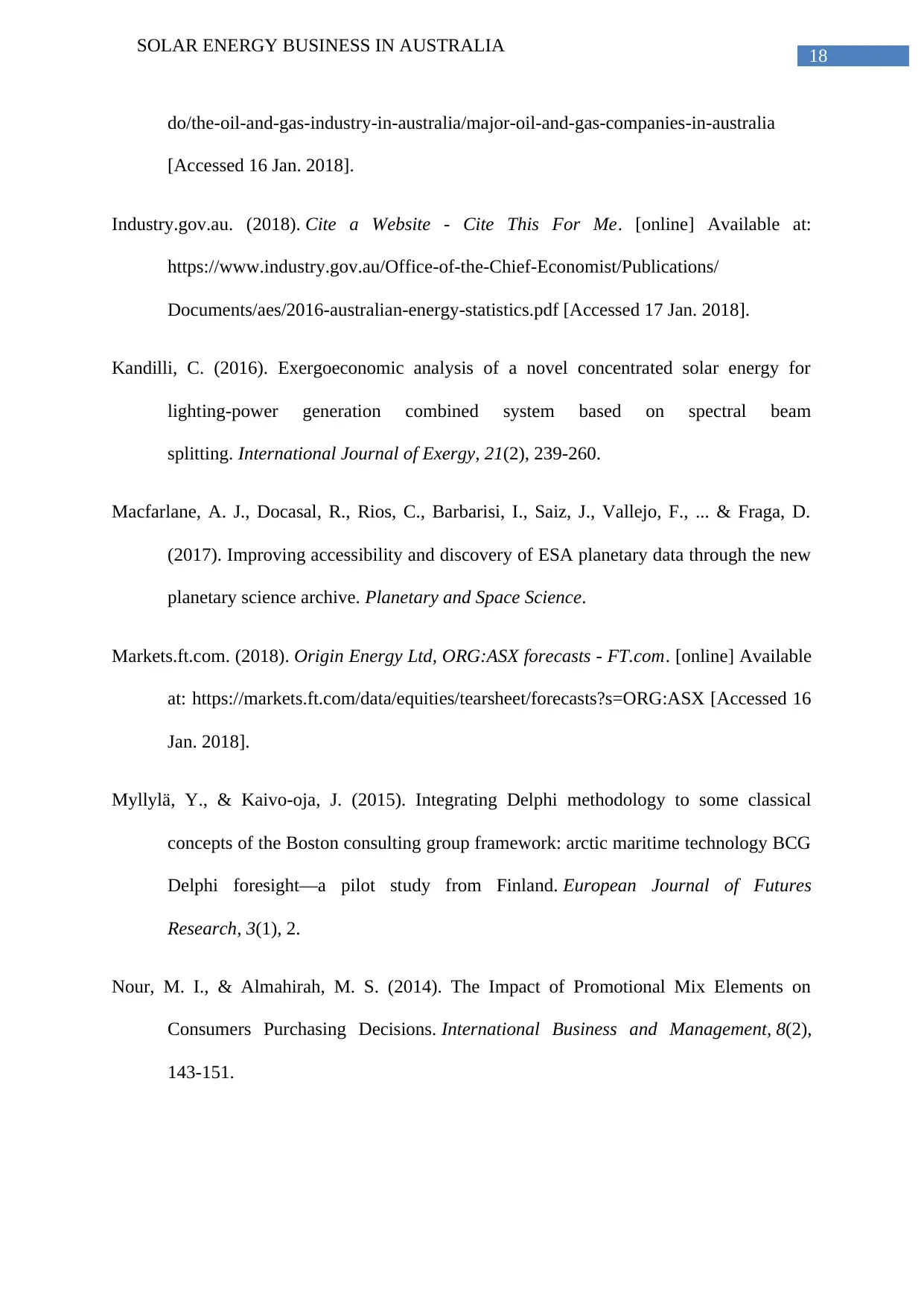
18
SOLAR ENERGY BUSINESS IN AUSTRALIA
do/the-oil-and-gas-industry-in-australia/major-oil-and-gas-companies-in-australia
[Accessed 16 Jan. 2018].
Industry.gov.au. (2018). Cite a Website - Cite This For Me. [online] Available at:
https://www.industry.gov.au/Office-of-the-Chief-Economist/Publications/
Documents/aes/2016-australian-energy-statistics.pdf [Accessed 17 Jan. 2018].
Kandilli, C. (2016). Exergoeconomic analysis of a novel concentrated solar energy for
lighting-power generation combined system based on spectral beam
splitting. International Journal of Exergy, 21(2), 239-260.
Macfarlane, A. J., Docasal, R., Rios, C., Barbarisi, I., Saiz, J., Vallejo, F., ... & Fraga, D.
(2017). Improving accessibility and discovery of ESA planetary data through the new
planetary science archive. Planetary and Space Science.
Markets.ft.com. (2018). Origin Energy Ltd, ORG:ASX forecasts - FT.com. [online] Available
at: https://markets.ft.com/data/equities/tearsheet/forecasts?s=ORG:ASX [Accessed 16
Jan. 2018].
Myllylä, Y., & Kaivo-oja, J. (2015). Integrating Delphi methodology to some classical
concepts of the Boston consulting group framework: arctic maritime technology BCG
Delphi foresight—a pilot study from Finland. European Journal of Futures
Research, 3(1), 2.
Nour, M. I., & Almahirah, M. S. (2014). The Impact of Promotional Mix Elements on
Consumers Purchasing Decisions. International Business and Management, 8(2),
143-151.
SOLAR ENERGY BUSINESS IN AUSTRALIA
do/the-oil-and-gas-industry-in-australia/major-oil-and-gas-companies-in-australia
[Accessed 16 Jan. 2018].
Industry.gov.au. (2018). Cite a Website - Cite This For Me. [online] Available at:
https://www.industry.gov.au/Office-of-the-Chief-Economist/Publications/
Documents/aes/2016-australian-energy-statistics.pdf [Accessed 17 Jan. 2018].
Kandilli, C. (2016). Exergoeconomic analysis of a novel concentrated solar energy for
lighting-power generation combined system based on spectral beam
splitting. International Journal of Exergy, 21(2), 239-260.
Macfarlane, A. J., Docasal, R., Rios, C., Barbarisi, I., Saiz, J., Vallejo, F., ... & Fraga, D.
(2017). Improving accessibility and discovery of ESA planetary data through the new
planetary science archive. Planetary and Space Science.
Markets.ft.com. (2018). Origin Energy Ltd, ORG:ASX forecasts - FT.com. [online] Available
at: https://markets.ft.com/data/equities/tearsheet/forecasts?s=ORG:ASX [Accessed 16
Jan. 2018].
Myllylä, Y., & Kaivo-oja, J. (2015). Integrating Delphi methodology to some classical
concepts of the Boston consulting group framework: arctic maritime technology BCG
Delphi foresight—a pilot study from Finland. European Journal of Futures
Research, 3(1), 2.
Nour, M. I., & Almahirah, M. S. (2014). The Impact of Promotional Mix Elements on
Consumers Purchasing Decisions. International Business and Management, 8(2),
143-151.
Paraphrase This Document
Need a fresh take? Get an instant paraphrase of this document with our AI Paraphraser
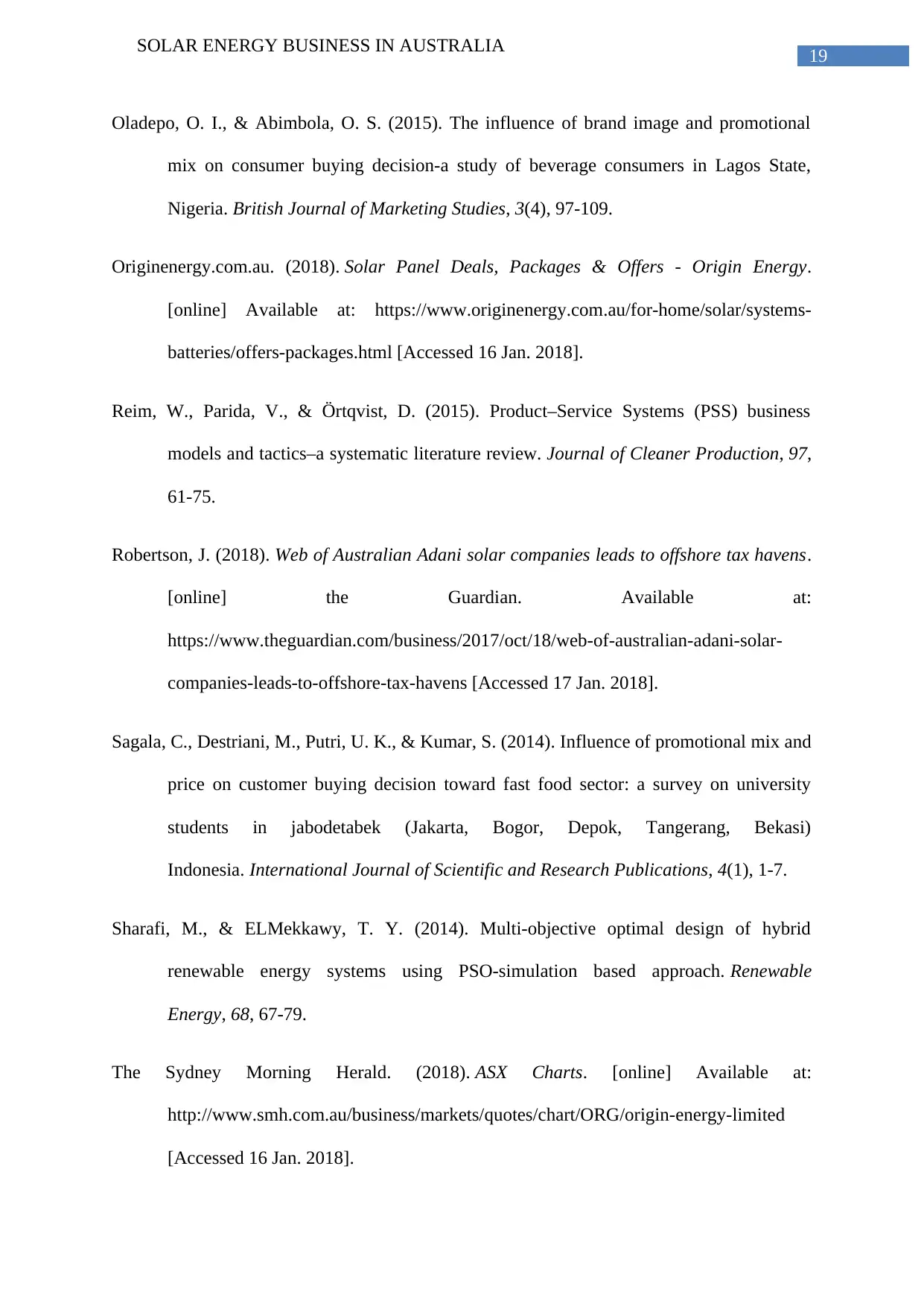
19
SOLAR ENERGY BUSINESS IN AUSTRALIA
Oladepo, O. I., & Abimbola, O. S. (2015). The influence of brand image and promotional
mix on consumer buying decision-a study of beverage consumers in Lagos State,
Nigeria. British Journal of Marketing Studies, 3(4), 97-109.
Originenergy.com.au. (2018). Solar Panel Deals, Packages & Offers - Origin Energy.
[online] Available at: https://www.originenergy.com.au/for-home/solar/systems-
batteries/offers-packages.html [Accessed 16 Jan. 2018].
Reim, W., Parida, V., & Örtqvist, D. (2015). Product–Service Systems (PSS) business
models and tactics–a systematic literature review. Journal of Cleaner Production, 97,
61-75.
Robertson, J. (2018). Web of Australian Adani solar companies leads to offshore tax havens.
[online] the Guardian. Available at:
https://www.theguardian.com/business/2017/oct/18/web-of-australian-adani-solar-
companies-leads-to-offshore-tax-havens [Accessed 17 Jan. 2018].
Sagala, C., Destriani, M., Putri, U. K., & Kumar, S. (2014). Influence of promotional mix and
price on customer buying decision toward fast food sector: a survey on university
students in jabodetabek (Jakarta, Bogor, Depok, Tangerang, Bekasi)
Indonesia. International Journal of Scientific and Research Publications, 4(1), 1-7.
Sharafi, M., & ELMekkawy, T. Y. (2014). Multi-objective optimal design of hybrid
renewable energy systems using PSO-simulation based approach. Renewable
Energy, 68, 67-79.
The Sydney Morning Herald. (2018). ASX Charts. [online] Available at:
http://www.smh.com.au/business/markets/quotes/chart/ORG/origin-energy-limited
[Accessed 16 Jan. 2018].
SOLAR ENERGY BUSINESS IN AUSTRALIA
Oladepo, O. I., & Abimbola, O. S. (2015). The influence of brand image and promotional
mix on consumer buying decision-a study of beverage consumers in Lagos State,
Nigeria. British Journal of Marketing Studies, 3(4), 97-109.
Originenergy.com.au. (2018). Solar Panel Deals, Packages & Offers - Origin Energy.
[online] Available at: https://www.originenergy.com.au/for-home/solar/systems-
batteries/offers-packages.html [Accessed 16 Jan. 2018].
Reim, W., Parida, V., & Örtqvist, D. (2015). Product–Service Systems (PSS) business
models and tactics–a systematic literature review. Journal of Cleaner Production, 97,
61-75.
Robertson, J. (2018). Web of Australian Adani solar companies leads to offshore tax havens.
[online] the Guardian. Available at:
https://www.theguardian.com/business/2017/oct/18/web-of-australian-adani-solar-
companies-leads-to-offshore-tax-havens [Accessed 17 Jan. 2018].
Sagala, C., Destriani, M., Putri, U. K., & Kumar, S. (2014). Influence of promotional mix and
price on customer buying decision toward fast food sector: a survey on university
students in jabodetabek (Jakarta, Bogor, Depok, Tangerang, Bekasi)
Indonesia. International Journal of Scientific and Research Publications, 4(1), 1-7.
Sharafi, M., & ELMekkawy, T. Y. (2014). Multi-objective optimal design of hybrid
renewable energy systems using PSO-simulation based approach. Renewable
Energy, 68, 67-79.
The Sydney Morning Herald. (2018). ASX Charts. [online] Available at:
http://www.smh.com.au/business/markets/quotes/chart/ORG/origin-energy-limited
[Accessed 16 Jan. 2018].
1 out of 20
Related Documents
Your All-in-One AI-Powered Toolkit for Academic Success.
+13062052269
info@desklib.com
Available 24*7 on WhatsApp / Email
![[object Object]](/_next/static/media/star-bottom.7253800d.svg)
Unlock your academic potential
© 2024 | Zucol Services PVT LTD | All rights reserved.





